


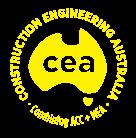

CONSTRUCTION CIVIL WORKS CIVIL ENGINEERING V8.03 CONCRETE INSTITUTE of AU STRALIA NOVEMBER 2022 PRINT POST APPROVED - 100001889 PROUDLY SUPPORTED BY PROUD MEDIA PARTNER
Innovative design relies on new ideas. Unlike any other, Fielders ARAMAX® Roof and Wall System can help you to bring new ideas to life. ARAMAX® is bigger, bolder and deeper than conventional steel cladding profiles. Delivering a distinct, signature aesthetic to your next project, ARAMAX® is the visual and functional choice for architects, designers, engineers and builders alike.
Aramax and Fielders are registered trademarks of BlueScope Steel Limited. © BlueScope Steel Limited. October 2022 ABN 16 000 011 058. All rights reserved.

fielders.com.au

You can do
with
ARAMAX® If you can
it
Fielders
imagine it.
Project: QANTAS Founders Museum by NRA Collaborative / Photography: John Elliot
Published by:
Editorial and Publishing
Consultants Pty Ltd

ABN 85 007 693 138
PO Box 510, Broadford Victoria 3658 Australia

Phone: 1300 EPC GROUP (1300 372 476) Int’l: +61 3 5784 2210
www.epcgroup.com

Publisher and Managing Editor

Anthony T Schmidt
Phone: 1300 EPCGROUP (1300 372 476) Mobile: 0414 788 900
Email: ats@epcgroup.com
Business Development Manager
Lawrence Whiter Mobile: 0418 543 821
Email: lawrencewhiter@bigpond.com
National Advertising Sales
Phone: 1300 EPCGROUP (1300 372 476) Int'l: +61 3 5784 2210
Email: ats@epcgroup.com
Advertising Sales - SA
Jodie Gaffney - AmAgo
Mobile: 0439 749 993

Email: jodie@amago.com.au
Advertising Sales - WA
Licia Salomone - OKeeffe Media Mobile: 0412 080 600 Email: licia@okm.com.au
Graphic Design
Annette Epifanidis Mobile: 0416 087 412
About the Cover
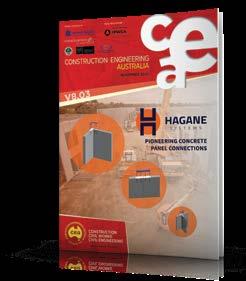
Benchmarking structural integrity, construction efficiency, safety & costs in the precast panel industry, Hagane Systems Panel Connectors were designed to save developers, builders and precast contractors time and money during construction while avoiding some of the everyday frustrations during the conventional concrete panel installation process.
Turn to Page 12 for the full story.
contents NOVEMBER 2022 Volume 8 Number 3
Registered
Post
100001889
2204-7247 TERMS AND CONDITIONS This publication is published by Editorial and Publishing Consultants Pty Ltd (the “Publisher”). Materials in this publication have been cre ated by a variety of different entities and, to the extent permitted by law, the Publisher accepts no liability for materials created by others. All materials should be considered protected by Australian and international intellectual property laws. Unless you are authorised by law or the copyright owner to do so, you may not copy any of the materials. The mention of a product or service, person or company in this publication does not indicate the Publisher’s endorsement. The views expressed in this publication do not necessarily represent the opinion of the Publisher, its agents, company officers or employ ees. Any use of the information contained in this publication is at the sole risk of the person using that information. The user should make independent enquiries as to the accuracy of the information before relying on that information. All express or implied terms, conditions, warranties, statements, assurances and representations in relation to the Publisher, its publications and its services are expressly excluded save for those conditions and warranties which must be implied under the laws of any State
Division
Practices
statutory modi
be liable for any damages including special, exemplary, punitive or consequential damages
not limited to economic loss or loss of profit or revenue or loss of oppor tunity) or indirect loss or damage of any kind arising in contract, tort or
even if advised of
possibility of such loss of profits or damages.
we use our best endeavours to ensure accuracy of
materials we create, to the extent permitted
excludes all liability for loss resulting
inaccuracies or false or misleading statements
Copyright ©2022 - EPC Media Group 4 26 42 2 Editorial 4 Industry News 4 EA News - Five Career-Changing Videos You Need to Stream 10 Case Study: Fielders Aramax 12 Cover Feature: Hagane Systems 18 Company Profile: Ascoat Industrial Flooring 20 Equipment Focus 26 Case Study: Using MasterSuna® RCT 323 Recycled Aggregate in New Concrete 32 Special Report: Dodge Construction Network Report Findings 34 Innovative Solutions 36 ACRS Feature 40 Digital Technology 42 National Precast News 46 Compliance Testing 18
by Australia
Publication No.
ISSN
of Australia or the provisions of
2 of Part V of the Trade
Act 1974 and any
fication or re-enactment thereof. To the extent permitted by law, the Publisher will not
(including but
otherwise,
the
While
the
by law, the Publisher
from any
that may appear in this publication.
FUNDING THE NEEDS OF A RAPIDLY GROWING (AND AGEING) RURAL AND REGIONAL POPULATION
Dear Readers,
While the area defined as ‘Rural and Regional Australia’ is clearly as diverse as Australia is large - with individual towns, cities and municipalities each facing their own particular circumstances and challenges - there does appear to be one major issue now facing rural and regional councils across the country, namely, the additional strain being placed on Local Government services and facilities as a result of a rapidly growing and ageing population.
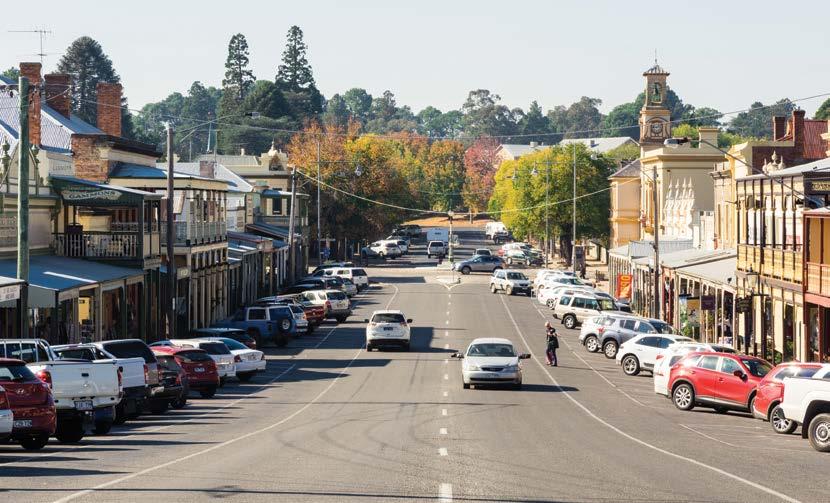
Whilst the issues relating to an ageing population are clearly also a major concern for metropolitan councils, the massive increase in people looking to make a ‘seachange’ or ‘tree-change’ following last year’s COVID chaos – many of whom are over 55 – is further compounding the issue for rural and regional councils.
Put simply, the significant population shift that has occurred over the past 12 months – especially from Melbourne and Sydney into the regions – together with the ever-increasing average population age gap between the city and the country, places a massive financial burden on rural and regional councils as they struggle to provide additional services and facilities.
In recent years, rural and regional areas have experienced a steep increase in the percentage of residents aged 55 or over. Together with the fact that most
Australians are now living longer, in rural areas it is common practice for those who have spent their life on the land to move ‘off the farm’ and into a nearby town when they retire - generally for reasons of better access to services.
Of course, moving out of the major capitals to rural and regional cities didn’t start with Covid either – it’s a trend that’s been growing steadily for a number of years. Covid simply accelerated it!
And it’s not only about a change in lifestyle. Many are simply taking advantage of the massive growth in property values that has occurred in the major capitals over recent years - selling up and trading up for more affordable real estate in regional areas.
While this has provided an economic boom for some areas, this growth is also proving to be somewhat of a doubleedged sword. Unfortunately, the increasing ‘age imbalance’ between the city and the country is a serious concern and is already shaping up as a major threat to many councils throughout rural and regional Australia. Councils are not only being faced with a sharp increase in demand for human services, they’re also under pressure to provide more suitable agerelated infrastructure, such as aged care facilities and community amenities.
In these days of tight fiscal policy and high community expectations, Local Government is undoubtedly accustomed
to being asked to ‘do more with less’ – a challenge which is further compounded by their restricted ability to raise revenue through rates and user charges. And while there has no doubt been an increase in rate revenues for some councils as a result of additional residences being built, it’s fair to assume that those increases have failed to cover the additional resources required to adequately provide for the increased population.
Be that as it may, there will surely come a time when there are quite simply no more funds available - and on current trends it appears that that time is rapidly approaching.
With that in mind, I believe that the only way that we can possibly hope to address these issues with any level of success, is for all levels of government to work together in a co-operative and equitable manner to develop the facilities and services that are needed.
After all, the population continues to age on a daily basis - and that leaves no time for political ‘buck passing’.
2 Construction Engineering Australia • November 2022 EDITORS COLUMN
MasterSuna® RCT 323

Returned concrete recycling made easy

MasterSuna® RCT 323 from Master Builders Solutions provides a fast, efficient and extremely easy-to-use recycling solution for returned ready-mixed concrete waste.
Simply add the dissolvable, water-soluble bags directly into the agitator drum of the concrete truck, spin it up for 60-90 seconds and empty it out. Next day, you’ll have a high quality gravel like material which breaks up extremely easily and is ideal for use as road base, construction backfill, or any number of applications. Call us today on 1300 227 300 or scan the QR Code for more information.
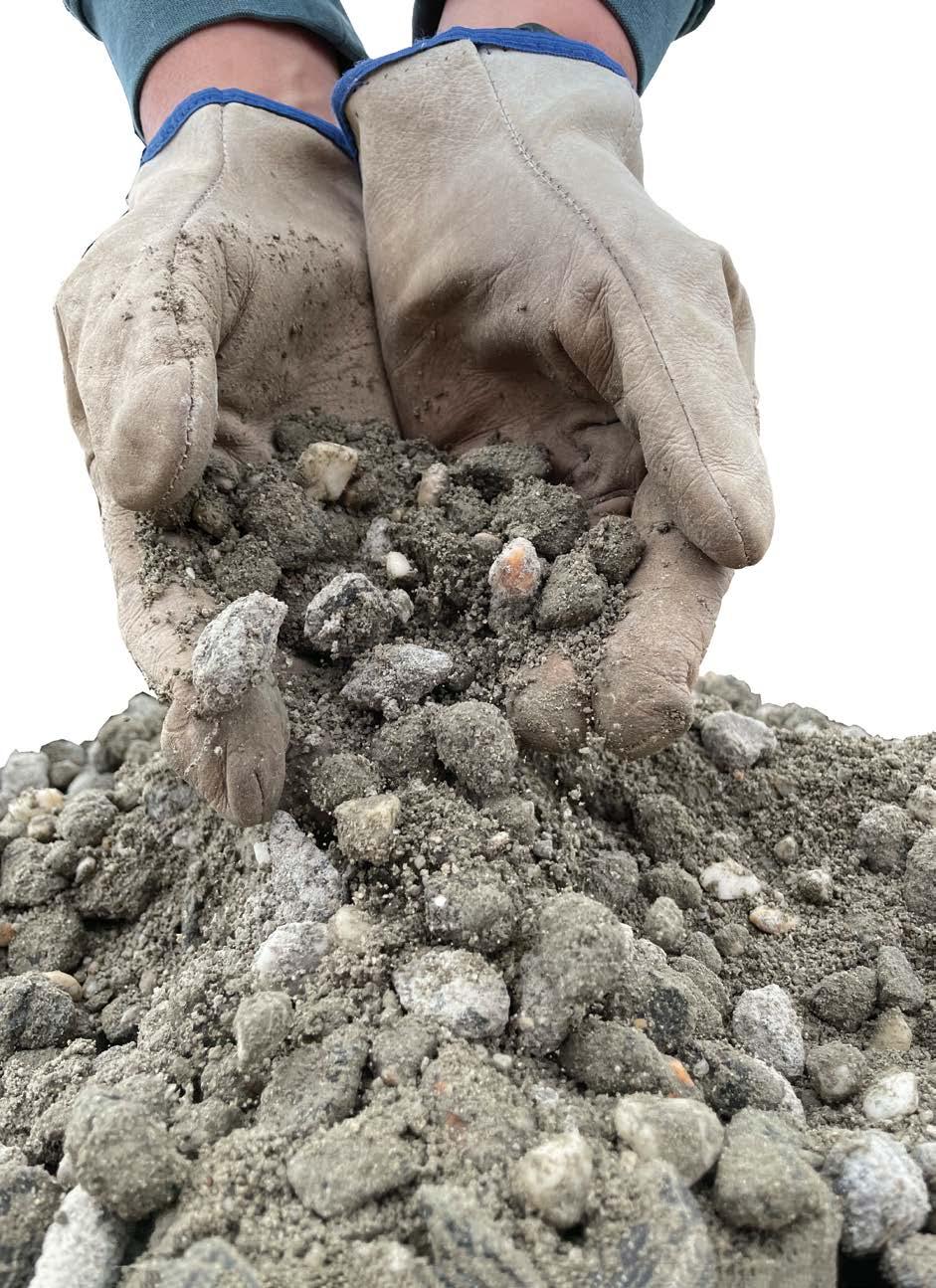
BUILDING TOWARDS A ZERO CARBON TARGET
The City of Melbourne is urging building owners, tenants, industry associates, facility managers and governments to transform and retrofit buildings in the CBD to reduce their carbon emissions and propel the municipality towards the ambitious goal of net zero emissions by 2040.




To reach the milestone, almost 80 Melbourne buildings each year would need major upgrades and refurbishments to improve energy performance – a significantly higher rate currently being delivered by the market.
Commercial buildings are responsible for 60 per cent of the city’s greenhouse gas emissions, while residential towers account for six per cent of emissions. Improving the sustainability of all new and existing buildings presents a significant opportunity to considerably reduce carbon emissions, while creating healthier workplaces and homes.
To help accelerate the current retrofit rate, Council has released a Zero Carbon Buildings for Melbourne discussion paper – outlining potential initiatives the City of Melbourne and partners could implement to support the transition of city buildings to net zero emissions.


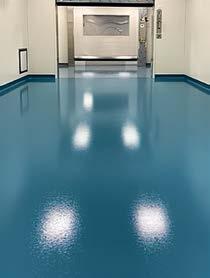
The paper proposes seven key initiatives:
• Developing zero carbon building leases – agreement between landlords and tenants to ensure the ongoing use and operation of zero carbon buildings
• Establishing a carbon risk tool –understanding the future risk of carbon for mid and low-tier buildings
• Incentivising periodic commercial building disclosure – a program to encourage periodic reporting of a building’s NABERS rating
• Promoting joint procurement – supporting lower grade and ungraded buildings to increase capacity to carry out deep retrofits jointly
• Convening zero carbon building retrofit teams – to create a more collaborative, relational way of working
• Incentivising building performance through rates – using rates to encourage emissions reduction
• Introducing an emissions cap through local law – establishing an emissions ceiling for buildings
Speaking about the City of Melbourne’s Zero Carbon Building Implementation Plan, Lord Mayor Sally Capp, said that the City is proud to be leading Melbourne’s transition to becoming a zero net emissions city by 2040, but that it can’t achieve this ambitious goal alone.
“By working alongside key industry, academic and government partners, we can accelerate our journey towards zero net emissions– reducing costs and improving our environment,” the Lord Mayor said.
“We want to hear from those involved in every facet of the building industry– so we can better understand how to empower
“We can lower our emissions, lower our energy bills, lower Covid transmissions, and importantly, bring workers back to the city through improving building sustainability,” Councillor Doidge added.
“We want to see our city buildings Zero Carbon Ready by 2040 or sooner, and we’re confident that this discussion paper will become a catalyst to kick start the transformation.”
Industry stakeholders, academics and community members are encouraged to have their say on the discussion paper via the Participate Melbourne online portal https://participate.melbourne.vic.gov.au/zerocarbon-buildings-melbourne
Feedback will inform the development of the to be delivered in mid-2023.
4 Construction Engineering Australia • November 2022 INDUSTRY NEWS
C M Y CM MY CY CMY K





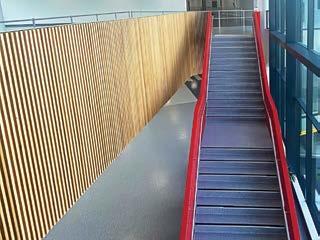




80 Industrial Drive, Braeside VIC 3195 | info@ascoat.com.au www.ascoat.com.au | Tel: +61 3 9587 7433 From fast, cost-effective concrete sealing solutions, through to high-build epoxy, self-levelled, chemical, temperature and static-resistant seamless installations, ASCOAT has the solution. Ascoat_Ad03_210x148_PRESS.pdf 1 11/11/22 12:37 pm
In line with the organisation’s global Planet Passionate 10-year sustainability program, the Australian division of Kingspan Insulated Panels has collaborated with GreenPower® and switched to 100 per cent renewable electricity to power its factory and office in the western Sydney suburb of St Marys.
GreenPower is managed by the NSW Government and helps households and companies source clean energy from providers that are accredited as renewable sources.

Using this 100 per cent renewable source of electricity enables Kingspan Insulated Panels to reduce the embodied carbon
of products manufactured at its St Marys location.

“As a manufacturer, Kingspan will benefit from reducing its carbon footprint and impact on the environment, and our customers will have peace of mind knowing that they are sourcing insulated panels manufactured with renewable sources,” Kingspan Insulated Panels general manager, Jonathan Wormwell said.
“As a leading supplier of insulated panels in Australia, this initiative is a significant move for Kingspan and the local building sector. Not only are we initiating carbon reduction at our manufacturing facility, but our products also enable customers to build thermally efficient buildings.
“High-performance buildings can contribute to lower long-term operational costs, which means the end customer also benefits by reducing their carbon footprint.
This initiative is a way for us to bring sustainability into another phase of the construction process,” he said.
Work is also underway to refurbish the St Marys factory roof and install solar PV panels for on-site renewable energy generation.
Kingspan’s global 10-year Planet Passionate sustainability program includes four key pillars: energy, carbon, circularity and water. With 12 measurable targets under these four pillars, every Kingspan business is responsible at a local level for meeting its Planet Passionate targets by 2030.
These targets include increasing the organisation’s direct use of renewable energy, reducing company waste in landfill, achieving net zero carbon manufacturing, and reducing product CO2 intensity from primary supply partners by 50 per cent.

KINGSPAN INSULATED PANELS REDUCES CARBON FOOTPRINT USING 100% RENEWABLY SOURCED ELECTRICITY WORLD LEADING REBAR MANUFACTURING EQUIPMENT Supporting and supplying to Australasia's leading reinforcing manufacturers for over 40 years. Backed by MEPGroup Italy, Machinery Indents have the structure, experience and advice to help you with rebar processing equipment • New and Used Machine Sales • Factory Layout Design • Programmed Maintenance • On/Offsite MEP Equipment Training • High Automation and Flexibility • Customer Solutions • Manual Handling Solutions • Technical Assistance • Genuine MEPGroup Spare Parts • Highest Quality Machinery • Manufacturing Process Consultation • Precast - Rebar Manufacturing Equipment MEPGroup Australasian Agent 43 Jesica Road, Campbellfield Victoria, Australia P: +61 3 9357 9769 F: +61 3 9357 0699 E: enquiries@mi-mep.com.au www.mi-mep.com.au 6 Construction Engineering Australia • November 2022 INDUSTRY NEWS
AMERICAN CONCRETE INSTITUTE ANNOUNCES INTERNATIONAL PARTNERSHIP WITH THE GLOBAL CEMENT AND CONCRETE ASSOCIATION
While exhibiting and participating in the recent PROCEMCO event in Cartagena, Colombia, the American Concrete Institute (ACI) and the Global Cement and Concrete Association (GCCA) were able to formalise their cooperative efforts by signing an International Partnership Agreement (IPA). This new agreement formalizes the desire to collaboratively develop and disseminate information on concrete, concrete structures, and especially on concrete sustainability. International Partners work with ACI to increase access to concrete information worldwide.
GCCA is the key driver of sustainability in the cement and concrete industry, working towards the goal of carbon-neutral concrete.
Representing 80% of global production outside of China, as well as key Chinese producers such as CNBM, the GCCA launched its 2050 Net Zero Roadmap in 2021, outlining the levers, milestones,

and pathways to achieve a decarbonized industry. This includes new technologies, innovations, and importantly - improving efficiency in design and construction. Here, the contribution of design and construction professionals to delivering carbon reductions through concrete projects is crucial. This partnership will support the dissemination of best practices to enable the specification of sustainable concrete and the design of lower carbon concrete elements and structures.
The agreement with the GCCA is part of ACI’s strategic plan to promote concrete sustainability and the use of ACIs concrete knowledge to assist concrete industry professionals globally to manage increasing requirements for the design of concrete structures.
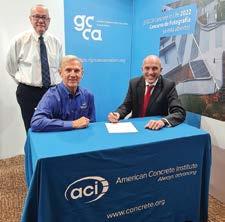
In addition, ACI recently launched NEU: An ACI Centre of Excellence for Carbon Neutral Concrete. NEU’s members include designers, contractors, material suppliers, as
well as consumers and owners of concrete structures. NEU aims to collaborate globally to drive research, education, awareness, and adoption of carbon-neutral materials and technologies in the industry, to reach the goal shared with GCCA – Carbon Neutral Concrete.
“ACI cooperates closely with our International Partners benefitting everyone in the global concrete community. ACI looks forward to working with the GCCA towards a future where everyone has the knowledge needed to use the latest concrete technologies effectively to meet the demands of a changing world.”
Learn more about ACI’s international activities at: www.concrete.org
Construction Engineering Australia • November 2022 7
FIVE CAREER-CHANGING VIDEOS YOU NEED TO STREAM NOW
No matter what field or industry you work in, there are skills that can be used in almost any workplace.
It’s not enough to simply know and understand your specific discipline and job role – you also need more expertise around things like project management, an understanding of finance, and digital skills.
Here are five webinars you can stream right now to help you build those skills:

1.Principles of learning
Believe it or not, most human beings aren’t great at learning. Despite our best intentions, we often undertake strategies that are either inefficient or ineffective. This video explores several principles of human learning that will help you move quicker and easier through the learning process. This, in turn, will help you move faster than others when tackling a new job, a new position, or a new project.
2.Values and purpose – building strong career foundations
During your working life, you will face many challenges and difficult decisions, with many variables that influence your decisionmaking.
Clear purpose and values form the basis of informed decision-making. Purpose is what inspires you and gets you to work each day, and your values are your guide that hold you accountable to your purpose.
But how can you work out what these are?
In this webinar, speaker Nigel Sutton will guide you through tools for discovering
your purpose, exploring your values and converting values from words into actions.
3.Elevate your emotional intelligence for career success
Emotional intelligence is the ability to understand, use and manage our emotions and recognise the emotions of others. It is a particularly useful skill in helping to develop successful interpersonal relationships with colleagues and stakeholders which in turn help you achieve and grow professionally. This webinar will help you build your emotional intelligence skillset, and will be useful to you if you:
• Need to build your emotional intelligence to anchor why you do what you do and build a value compass to guide you into the future;
• Need a quick hack to connect with people that actually works;
• learn the language that builds instant rapport with the person you are talking to;
• want to explore the truth behind who you think you are, who you want others to think you are and who your really are, to build your authenticity.
4.Networking and relationship building with colleagues and clients
Trust and likeability are just two of the keys to networking and building relationships with colleagues and clients. But how do you present the real you while also cultivating rich relationships that benefit you or your business?
Find out how to create a memorable and positive impression, identify opportunities for networking, explore what you can offer and what you want to gain, and develop your network with integrity.
This session will give you tips and tricks to start networking and growing your influence with stakeholders at your next event or meeting. It will be beneficial to those who are new to networking or would like to be more successful in their approach.
5.Time management under pressure
In the fast-paced world we live and work in, prioritising and self-management are key to success, building relationships and achieving results.
This session focuses on how to improve managing yourself and your time, to enhance your productivity, effectiveness and wellbeing.
Access career-changing resources like these and more with an Engineers Australia membership.
For a limited time, you can access over a hundred hours of the latest and most popular video content and presentations with a FREE 1-MONTH TRIAL.
SIGN UP TODAY
Scan the QR CODE or visit: https://l ead me/ EAcea1122

8 Construction Engineering Australia • November 2022 EA NEWS
C M Y CM MY CY CMY K

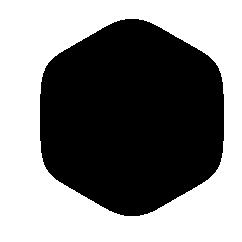
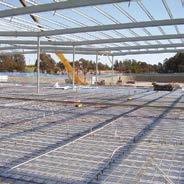






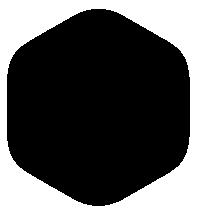
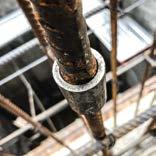




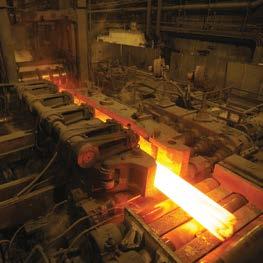





















































































THE ACRS DIFFERENCE www.steelcertification.com ACRS - Independent, Expert Third Party Certification & Verification of Reinforcing, Prestressing and Structural Steels for Compliance with Australian and New Zealand Standards Ph: (02) 9965 7216 | E: info@steelcertification.com ABN: 40 096 692 545 üIndependent ACRS is a steel certification scheme for steel users, and independent of product suppliers. So you know ACRS is working for you; üExpert All ACRS auditors and technical sta are qualified and experienced in the manufacture of the materials ACRS certifies. So with ACRS you know certified materials have been audited and approved by people who understand them; üComprehensive ACRS certifies all steel products, from all manufacturing locations to all scheme standards. So with ACRS you know all listed products are covered, not just some; üRigorous ACRS audits every major site at least once every year. So with ACRS you know certificates are up to date;
During every audit, ACRS takes samples
standard production and
production data
you
supplied materials are assessed regularly; üContinuous ACRS uses only selected laboratories to ensure accurate results independent of the supplier, and matches these
the supplier’s production data to monitor the supplier’s consistency.
üVerified
at random from
checks
every three-months. So with ACRS
know
with
Fielders ARAMAX® is picture perfect for Bundanon Art Museum
Rising from the wooded and undulating landscape in Bundanon near Nowra, New South Wales sits an intriguing structure – part trestle bridge, part rural shed; the dark steel-clad building is bold and purposeful, yet seems at one with its surroundings.
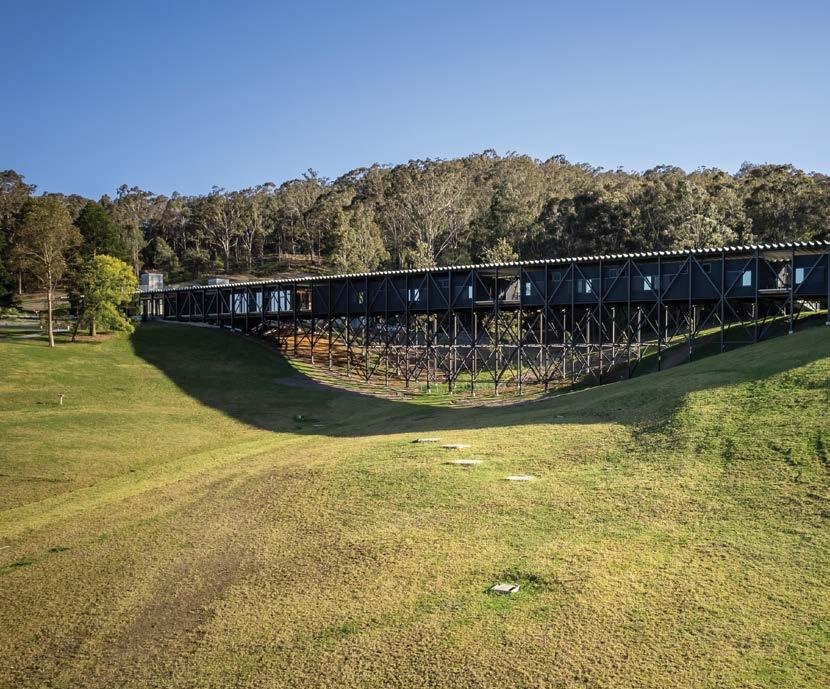
Completed earlier this year, the striking building forms part of the recently opened Bundanon Art Museum, which was constructed on 1100 hectares of land that renowned Australian painter, Arthur Boyd and wife, Yvonne, gifted the nation in 1993.
New works at the property comprise of site infrastructure and two buildings – the Art Museum which is embedded in the landscape and houses the Bundanon Trust’s $46 million collection of Arthur Boyd artworks, and ‘The Bridge’. The Bridge is used as a creative learning centre for school children and also provides accommodation – it’s suspended high above a gully, and it’s a good thing too because the area below is prone to flooding.
The project was conceived by leading Melbourne architectural firm, Kerstin Thompson Architects (KTA), who carefully balanced aesthetic requirements with the need to deliver buildings that would be resistant to both flooding and bushfires.
KTA Architect, Lloyd McCathie said that the design brief called for the realisation of the client’s purpose: to foster an appreciation of art in the landscape in line with Arthur Boyd’s vision.
“The design addresses how buildings and landscapes can be resilient and resistant,” Lloyd said.
“Both structures needed to be resistant to fire and resilient to flood, wind, and sun; in particular The Bridge (a 165-metre-long by a 9-metrewide structure), where in the spirit of Boyd’s practice of painting ‘en plein air’, climate variation is central to visitor experience.”
Fielders ARAMAX® was the roofing material of choice for The Bridge. This steel roofing profile is becoming a popular choice for commercial and industrial building applications, where its rigidity, long-spanning qualities and low maintenance benefits are finding favour with architects and industrial designers.
“The ARAMAX® roof with its clear spans over The Bridge, functions as a parasol, shading the breezeway spaces and accommodation rooms which have their own independent roofs below, while allowing air flow and views of the landscape along the length of the Bridge,” Lloyd explained.
“The long spans of ARAMAX® also removed the need for additional structural steel framing. This meant that the purity and clarity of the roof as a parasol was evident along the length of The Bridge, uninterrupted by additional steel members.
“The roof was deliberately lifted above The Bridge allowing light and air penetration into the spaces below – the profile of the elevated ARAMAX® cuts a datum across the site, registering the roof against the landscape. To reinforce this principle, ARAMAX® was specified as galvanised finish, while the structure which supported it is painted black.
“A custom underslung gutter was also designed thanks to the design freedom allowed by the ARAMAX® parameters.”
10 Construction Engineering Australia • November 2022 CASE STUDY
As well as helping to meet the design vision for the project, ARAMAX® delivered the required performance measures when it came to BAL requirements and having low-maintenance qualities. At the time of the Black Summer Fires during the 2019-20 bushfire season, fires came within a kilometre of the location, which reinforced the need to incorporate high bushfire resistance in any future builds.
“ARAMAX® was selected for its robustness, resilience and longevity in the context of a remote, flood and bushfire-prone environment. Low maintenance, integrated colour materials were selected to reduce reapplication of finishes over time,” Lloyd explained.

“Being located in a bushfire prone area, The Bridge was required to be BAL29 – as a parasol room, the ARAMAX® needed to be non-combustible.

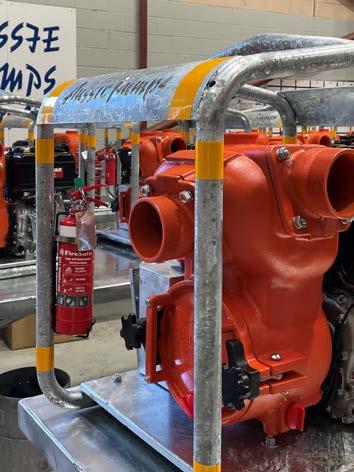
“Bundanon is a regional site, and the client also needed low maintenance materials to reduce the ongoing operational costs, and minimise risks associated with material and labour availability at a regional location.”
The construction process using ARAMAX® also had advantages according to the architect, with the sheets delivered to site preformed and in the required lengths, allowing fast and efficient installation. The successful application of Fielders ARAMAX® has also led KTA to evaluate its use for several of the consultancy’s new projects, including perforated ARAMAX® as façade cladding for a tertiary institution.

For information on the full Fielders Aramax® range, visit: https://fielders.com.au/products/platinum-portfolio/aramax/

size of ad .... 88mm x 135 mm ü 5 year pump warranty 4" TRASH PUMP ... DIRTY WATER SPECIALIST ü Self priming to 7.6m ü Fast, easy set up ü Flows to 1,600 lpm ü 10HP Yanmar diesel 4" DIESEL TRASH PUMPS Australian Pump Industries Aussie Pumps 02 8865 3500 aussiepumps.com.au AUSSIE PRODUCTION SOARS we’reforAustralia 1300 240 337 www.enviroblast.com.au EnviroBlast Australia Mobile Media Blasting - Soda & Garnet • Specialising in Concrete preparation for Carbon Fibre application • Abrasive & Non-Abrasive Blasting • Paint, rust & contaminant removal from many substrates • Line marking removal • Graffiti removal & protection • Removal of sealers & coatings • Creation of non-slip surfaces • Compact machinery for easy access • Low media usage which means less environmental issues with reduced containments and dust • Suitable for confined space blasting Construction Engineering Australia • November 2022 11
BENCHMARKING STRUCTURAL INTEGRITY, CONSTRUCTION EFFICIENCY, SAFETY & COSTS IN THE PRECAST PANEL INDUSTRY
Hagane Systems Panel Connectors were designed to save developers, builders & precast contractors time and money during construction while avoiding some of the everyday frustrations during the conventional concrete panel installation process.
Hagane Systems' series of panel connectors & panel ties are delivering an industry-leading level of efficiency on site, allowing contractors to complete work 3X faster & safer than ever before with the amount of time and personnel spent working at a dangerous height is minimised.
The PC series of Hagane Systems Panel Connectors eliminate the need for cast-in plates/stitch plates and removes welding and patching from the connection process entirely.
In addition, the PT series of panel ties completely eliminates the design requirement of structural wall ties, reducing overall steel costs significantly for the builder.

With the complete system decreasing construction time, costs and on-site resources, Hagane Systems is benchmarking structural integrity, construction efficiency, safety & costs in the precast panel industry.
The current method of connecting concrete panels together has been used since the 1970's and involves a tedious and timely process.
Off-site, the embedding of cast-in plates into two concrete panels at precise locations can often lead to future on-site rectification.
On-site, threaded bolts are initially installed to connect the stitch plate to the two cast-in plates, followed by the welding of the stitch plate across both embedded cast-in plates.
This connection process is then finalised by the patching of these voids. Only then can the panel join be caulked.
Overall, the current process of connecting panels requires:
• Two trades (Welder & Patcher)
• Three seperate EWP required processes (Bolt, Weld, Patch)
• Overall construction time in excess of 60 minutes per panel connection
Hagane Systems decided that there had to be a better way.
A
12 Construction Engineering Australia • November 2022 COVER FEATURE
NEW ERA OUTDATED TRADITIONS
The PC range of connectors replaces the need for traditional stitch plates, eliminating welding and patching from the process with a simple one minute install time.
While the PT range of connectors replaces the need for conventional wall ties, reducing steel costs significantly. PC1.01
IMPROVED SAFETY REDUCED COST
Since the introduction of prefabricated and tilt-up concrete construction in Australia, Engineers and panel contractors have tried various methods to connect concrete panels, where currently the most widely adopted solution is a cast-in plate.
This technology requires consideration of working at heights, welding on-site, and includes various crews to fix the connection after the panel is erected. Put this together with site congestion and various crews on-site, whilst cast-in plates are being welded, makes safety of site personnel a major factor for this type of connection.
Hagane Systems Panel Connectors positively addresses many of the human safety concerns experienced with cast-in plates.
Time on-site is minimised, the time for working at height is considerably reduced, and no hot work permit is required. Further benefits include the reduction of different trades needed for the installation of the Hagane Systems Panel Connector.
The goal at Hagane Systems during the design process was to achieve a solution where Developers, Builders and Precasters could all benefit.
Engineers always strive to provide their clients solutions that are structurally sound, cost effective and efficient.
Rarely can a solution successfully achieve all three simultaneously, but Hagane Systems Panel Connectors make this possible..while at the same time, improving safety for the workforce.
Developers, Builders and Precasters see a direct cost saving, with various tasks being reduced or entirely eliminated from the construction process.
• Welding Labour Costs - Eliminated
• Patching Labour Costs - Eliminated
• Steel Wall Tie Costs - Eliminated

• Plant Hire - Reduced
• Prop Hire - Reduced
2 MINUTE INSTALL ENGINEERED STRENGTH
The entire process of installing Hagane Systems Panel Connectors, from application of grout to positioning the metal connector is only 2 minutes. On average, installers are doing 100 connections per day, in comparison to traditional cast-in plates where the industry average is 25-30 connections per day.
Engineers Feedback...
Our clients frequently ask how we can save money and decrease construction time, and with the Hagane system we are able to provide them both.
The conventional panel tie and cast-in plates has long been the standard components holding panel together in typical warehouse design. The Hagane System of connectors represents an innovative solution to an antiquated method of connecting concrete panels.
As with all new products introduced to the market, once the engineering concepts are understood (which are very similar to the way we currently design) it’s not difficult to provide our clients with an alternative to the conventional system being Hagane.
Our team are happy to use Hagane panel connectors in future projects.
Danny Borzillo Director at Intrax Consulting Engineers
Hagane Systems' new and innovative concrete panel connections is a solution that provides superior structural integrity.
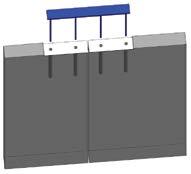
Determining bending capacity, or "Nominal Section Moment Capacity (fMsx)" is a make up of various elements, in which Hagane Systems Panel Connectors out performed the cast-in plate significantly:
Element Hagane PC1.01 Vs. Cast-In Plate Ixx - Second Moment of Area of a Cross-Section +2,397% Zxx - Elastic Section Modulus +399% Rx - Radius of Gyration +398% Zex - Effective Section Modulus +400% oMsx -
Furthermore, the technology of connecting prefabricated concrete panels using the Hagane Systems Panel Connector, will adopt current engineering design and testing standards.
The design methodology structural engineers can use when specifying the Hagane Systems Panel Connectors is now more transparent, compared to what is currently being used in the industry for design of cast-in plates.
For the full range of reports on the Hagane Systems Panel Connectors, head to www.hagane.com.au/engineers-hub
PT1.01
Nominal Section Moment Capacity +399%
Construction Engineering Australia • November 2022 13
HAGANE SYSTEMS : CASE STUDY
DELIVERING UNPRECEDENTED SAVINGS AT CONO BUSINESS PARK
As the construction industry demonstrated during the pandemic, builders and contractors alike were faced with the challenge where the supply of construction materials was an issue, together with costs increasing.
With Momentum Building & Development (MBD) being open to new and innovative construction methods and efficiencies, Hagane Systems was an adopted system where construction material supplies, together with on-site labour requirement were both significantly reduced.
Over the years, MBD constantly identified the time and costs associated with conventional precast panel connections.
"Watching various trades being involved in connecting concrete panels, all being challenged by access and weather constraints, MBD believed there had to be a better solution."
After being introduced to Hagane Systems through their structural engineer, MBD adopted the system for their current build project and re-designed the structural engineering to incorporate and introduce the detail of Hagane Systems panel connectors and panel ties at the CONO Business Park which comprised of 63 Warehouses.
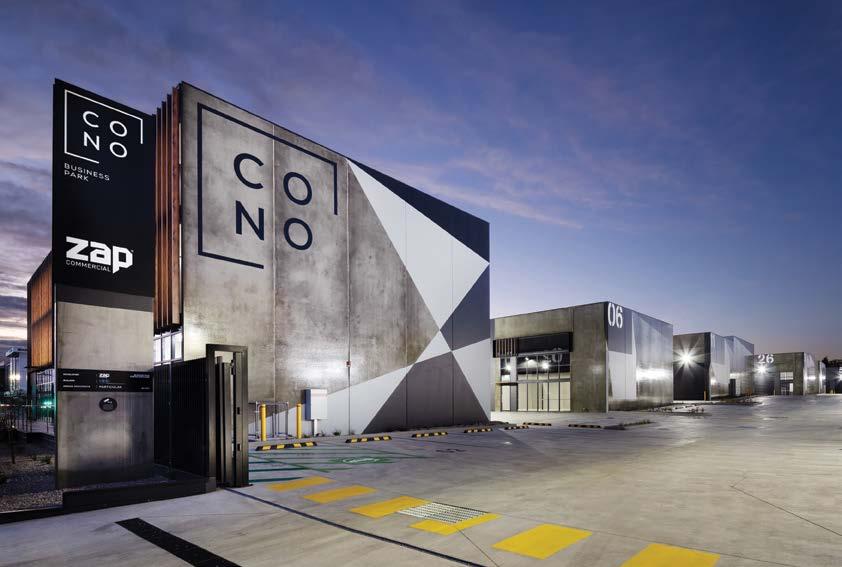
With the decision to adopt the Hagane System Panel Connector range, the difference in construction timing and quality of finishes was clearly evident.
"We couldn't believe our eyes. The seamless and simple process of installing grout, followed by a Hagane Systems Panel Connector, whilst allowing the grout to set, had contractors installing and connecting up to 100 concrete panels a day. All during the process in which any visible connections or patching of our finished panels was eliminated, producing the cleanest finish product MBD have ever delivered."
Not only had MBD found the answer for better efficiency on site, but the cost savings achieved at a time where the construction industry was at the mercy of unprecedented rising costs was the biggest surprise.
"The efficiency of the overall system had a significant impact on reducing various costs, including labour, plant & equipment hire. But with the PT1.01 replacing conventional wall ties, we saved over $90,000 in steel costs. Needless to say, Hagane Systems is, and will be our solution for all precast panel projects moving forward."
"The efficiency of the overall system reduced various costs including labour and plant hire, but with the added bonus of PT replacing conventional wall ties, we saved over $90,000 in steel costs."
14 Construction Engineering Australia • November 2022 COVER FEATURE
Richard Prosenik - Director at MBD



Customer Feedback... “As a construction firm focused heavily on panel related projects, we look for any cost and efficiency advantage possible so long as it doesn’t affect the safety of our staff and quality of our finished product. Hagane Systems has allowed us to save money on plant and labour with our installers connecting panels in minutes, while eliminating welding and patching. And now our finished panels look cleaner than ever before”
C3 Construction
HAGANE SYSTEM ENGINEERS HUB EVERYTHING YOU NEED FOR YOUR NEXT PANEL PROJECT The Hagane Systems website has all the resources required for Engineers, Builders & Precast Contractors to determine if Hagane Systems Panel Connectors are suitable for their upcoming panel project. By heading to www.hagane.com.au/engineers-hub you will have access to detailed information for: • Panel Connector Catalogue • Panel Connector Drawings (PDF & CAD) • Engineers Reports • Technical Information Sheet • Certification Documents • Installation Videos & Instructions • Case Studies • Steel Savings Calculator • Online Order Form In addition to the website resources, the team at Hagane Systems are always on hand for any questions or additional information you may require. For all Engineering enquiries contact: Robert Cilia - robert@hagane.com.au For all Sales enquiries contact: Steven Adamic - steve@hagane.com.au HAGANE SYSTEMS STEEL SAVINGS CALCULATOR
Hagane Systems Steel Savings Calculator can give you an on the spot estimate on
money you could save on your
panel project
wall ties with Hagane
Connectors.
plans,
savings estimate
market steel prices.
Hagane
panel project. Construction Engineering Australia • November 2022 15
Sebastian Canzoneri
Director at
Group
The
how much
next
by replacing your conventional
Systems PT1.01
Simply head to www.hagane.com.au/engineers-hub, enter the lineal metre amount of wall ties you have on your current
under the correct steel type, and the calculator will estimate the quantity of PT1.01 connectors required, along with
based on current
*Please consult your engineer to see if
System PT1.01 Panel Ties are suitable for the location of your









inspection data - from historical reports, photos and videos, through to current drone imaging and LiDAR data - to provide asset owners and managers with a comprehensive condition report for their assets. Our AI-based predictive analytics utilise your current and historical data to prioritise maintenance requirements and optimise your infrastructure asset management activities. T: 1300 552 878 www.dynamicinfrastructure.com.au
AI MEETS All of your asset data…
WHERE










Tested by certified engineers, Dynamic Infrastructure utilises proven, cutting-edge AI technology to provide asset owners and maintenance managers with actionable insights to save money and increase maintenance e ciency. • Identify defects before they evolve into large-scale failures • Prevent unplanned expenses & manage risk • Maximise warranty through automated tracking of repairs • Gain full field-to-o ce visibility Delta +25% since 2018 Corrosion Spall Delta +25% since 2015 Crack Delta +12% since 2017 Right at your fingertips ASSET MANAGEMENT DISCOVER MORE
ASCOAT

Melbourne-based specialist industrial flooring applicators ASCOAT has been providing seamless epoxy and high-performance polyurethane flooring solutions for clients large and small across Australia and beyond for over 30 years.
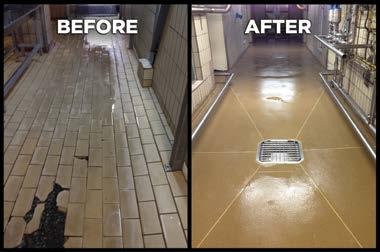
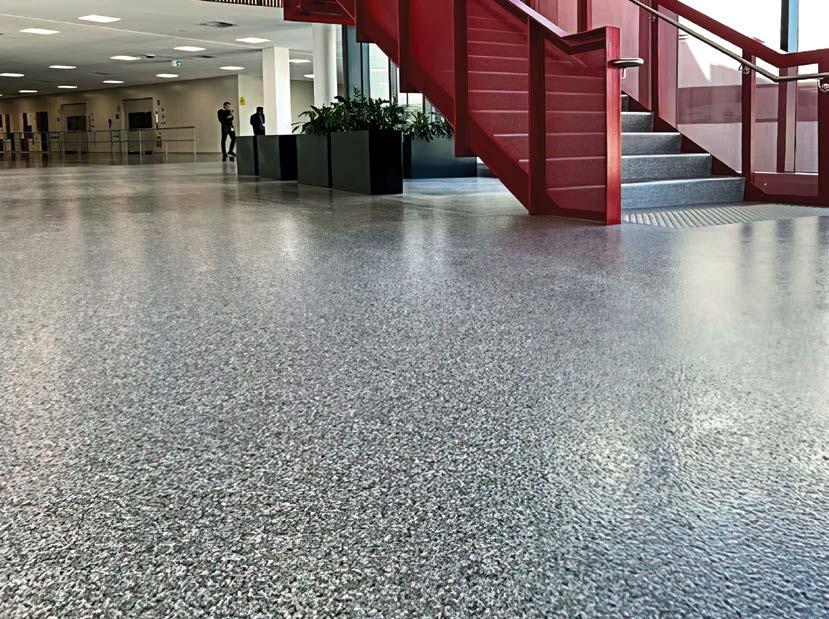
While remaining strong in business for over three decades is no mean feat in itself, this wholly Australian-owned and operated company has not merely ‘survived’ the many challenges facing all businesses (particularly those of the past 2½ years), it continues to grow and thrive. Indeed, the quality and performance of ASCOAT’s range of industrial flooring solutions have not only seen the company continue to grow and prosper, they have also earned it an enviable reputation for excellence across a range of industry sectors, including:
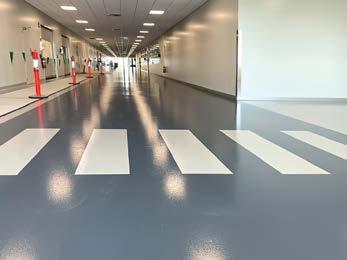
Flooring Applicators
Seamless Epoxy & Polyurethane
Industrial Floor
• Pharmaceutical & Clean Room • Food and Beverage Processing • Light and Heavy Manufacturing • Dairy & Agricultural • Utilities & Infrastructure • Warehousing and Logistics • Retail and Food Service • Education and Public Facilities • Motor Vehicle Sales & Service Facilities
Surfacing
wet processing
18 Construction Engineering Australia • November 2022 COMPANY PROFILE
From heat and chemical-resistant polyurethane floors for demanding
environments; ultra-smooth, highly chemical & impact resistant floors for clean rooms and similar environments; and heavy-
Powering a Sustainable Future
duty chemical lining systems for primary & secondary containment areas, ASCOAT offers a wide range of heavy-duty industrial flooring solutions. ASCOAT also offers an array of high-performance decorative flooring systems for public areas, retail, health & educational facilities; static control & low friction surfaces; as well as a selection of economical and rapid sealing and dust-proofing solutions for warehouses, factories and car parks.
Together with new floor installations, ASCOAT provides maintenance and remediation solutions for worn and damaged floors, joints, coves, line marking, tactiles and safety barriers.
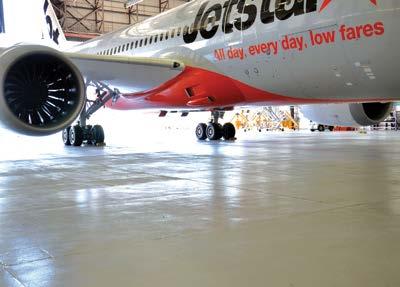



The company’s team of fully-trained, qualified and experienced staff have the specialist skills and expertise to deliver the optimum flooring solution to suit even the toughest environments. What’s more, as a wholly Australian-owned and operated, company ASCOAT has the local knowledge and experience, as well as the resources and personnel to meet the demands of projects of all sizes and complexity - from small maintenance and remediation works, through to the largest major capital works and infrastructure projects.
Importantly, ASCOAT’s Total Project Management approach incorporates a comprehensive Operational Site QA Program as well as full end-to-end Quality & Management Systems to help ensure quality, scheduling and budget is achieved on every project.
For further information on the full range of ASCOAT Industrial Floor Surfacing products and solutions, visit: www.ascoat.com.au or call (03) 9587 7433.
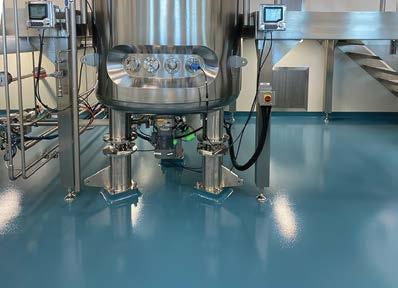

Did you know you can access the latest issue of Construction Engineering Australia via Informit?
The Informit Engineering Collection is an ever expanding resource covering aspects of municipal engineering – urban management and planning, civil engineering and construction, environmental management, planning issues and traffic management. The database offers an extensive variety of resources including journals, trade publications, reports and conference proceedings.
The Collection guarantees quality through partnerships with peak professional bodies including Engineers Australia and the Institution of Professional Engineers New Zealand, as well as Content Providers including EPC Media Group.
The Informit Engineering Collection delivers hard to find content designed to complete and complement all your construction engineering requirements. Other key titles published by EPC Media include: Highway Engineering Australia Waste + Water Management Australia
Request a quote or free trial via www.informit.org/trial-and-quote
Research for your global future
Construction Engineering Australia • November 2022 19
DeWalt Polyurethane Wet and Dry Vacuums
Durable wet and dry vacuum solutions to suit worksites of every size
Whether it’s the result of a major flooding disaster, or the more usual instances of dirt and debris on site, a wet and dry vacuum is a versatile piece of equipment for tackling cleanups. With the capacity to clean all types of solid and liquid waste, including gullies, drains and spills as well as dust, scraps and large debris, wet and dry vacuums are an essential piece of cleaning equipment for most trade environments including factories, building sites and garages.
However, not all wet and dry vacuums are created the same, and different models will have a variety of functions tailored to suit particular environments. From the carpenter, electrician, plasterer, painter, builder or those on construction and demolition sites, onsite knocks and collisions are an everyday occurrence and a key factor to consider when investing in a wet and dry vacuum is durability.
“Hardwearing equipment is essential for the tool-conscious tradesperson,” says Chiara Vozzo, DeWalt Wet and Dry Vacuum Product Manager from Mayo Hardware.
“To ensure longevity in keeping their cleaning tools in top shape, it’s important to invest in quality items.”
With that in mind, DeWALT’s range of polyurethane wet and dry vacuums offer increased durability as a result of the hardwearing and impact-resistant polyurethane.
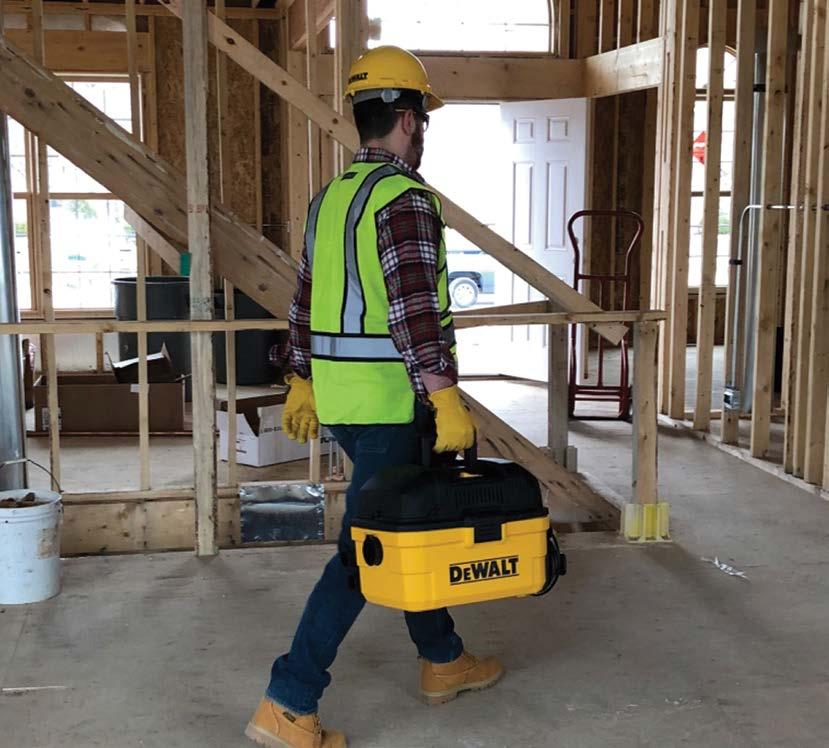
“The products will not dent, no matter what they’ve collided with on the worksite,” says Vozzo. “As is the peril of many a tool on the worksite, once an item gets dented, the damage is irreversible.”
Boasting a range of stand-out features, the versatile DeWalt Polyurethane Wet and Dry Vacuum range includes a number of models.
Offering maximum performance, even in the toughest conditions, the range is designed to
meet the demands of every trade environment and is available in a variety of sizes. From the compact and portable 15L model, to the 61L design which features a powerful 1400-watt motor, each model features with the same robust attributes and heavy-duty performance capabilities in a lightweight design.
“While stainless steel may instinctively feel more heavy duty, polyurethane is in fact the sturdier material in this instance, as the material is able to absorb an impact without getting damaged. For this reason, the DeWALT range of polyurethane wet and dry vacuums come with an industry-leading 10-year warranty,” says Vozzo.
“Polyurethane wet and dry vacuums are also lighter and easier to manoeuvre than their stainless-steel contemporaries, making them more health and safety friendly. In fact, on average, a DeWALT polyurethane wet and dry vac is 10% lighter than a stainless-steel version.
20 Construction Engineering Australia • November 2022 EQUIPMENT FOCUS
Lightweight and portable, the DeWALT DXV15T 15L Portable Wet and Dry Vacuum is the perfect tool to take to any job with its convenient toolbox shape and carrying handle.
This makes a big difference on site, particularly when the drum is full of water,” Vozzo says.
“Furthermore, with DeWALT’s range of polyurethane vacuums, there is no chance of rust or corrosion,” Vozzo added. “This is important as the equipment is often used outside and exposed to the elements which will almost certainly affect the stainless-steel drum over time which may lead to rust, corrosion and a dramatically reduced lifespan.”
The DeWALT Wet and Dry Vacuum range features five models:
DXV15T
The DeWALT 15L Portable Wet and Dry Vacuum is the perfect tool to take to any job with its convenient toolbox shape and carrying handle. Included is a washable and reusable cartridge filter that features a Clean-Connect™ locking system to allow for easy and secure installation and it can pick up dry and wet debris.
DXV23P
The DeWALT 23L wet and dry vacuum is portable and convenient for small jobsite
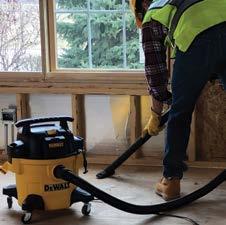
Larger models range from this DXV23P 23L capacity unit, through to DXV61P which features a massive 61L capacity and a 6-metre power cord for maximum ease-of-access around the worksite.
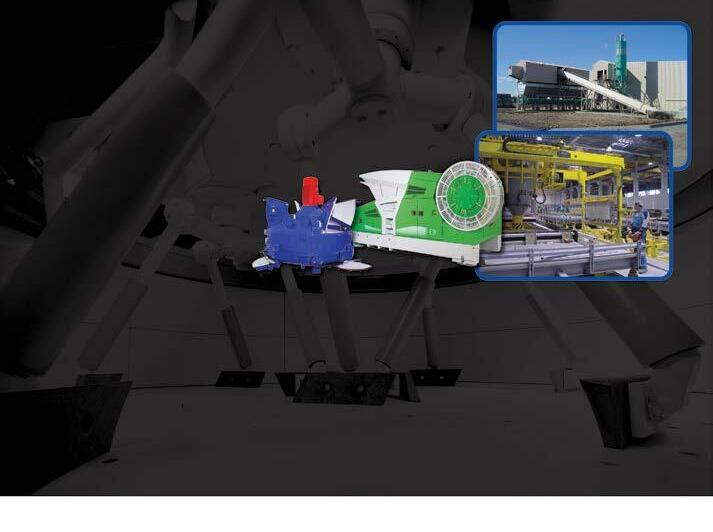
clean-ups. With a powerful heavy-duty motor, it provides strong suction for jobsite cleaning and features a fine-dust cartridge filter for dry debris and wet materials. The model is also equipped with a convenient carrying handle that doubles as a place to store the power cord.
DXV34P
The DeWALT 34L wet and dry vacuum features a powerful motor that provides strong suction and a large, 34L capacity for large jobsite applications. It has a built-in blower port to blow away sawdust and workshop debris, and 4 high-quality casters that allow smooth swivelling in any direction.
DXV45P
The DeWALT 45L wet and dry vacuum provides the ideal combination of performance, bin capacity and convenience for use on the job or in the shop. It also has a built-in blower port to blow away sawdust and workshop debris, and 4 high-quality casters that allow smooth swivelling in any direction.
DXV61P
The DeWALT 61L wet and dry vacuum has the power, durability and capacity for large jobsite applications. A sturdy handle and 4 high-quality swivelling casters allow for easy manoeuvrability around the site, with plenty of reach thanks to its built-in 6-metre power cord. Further features include a built-in blower port to blow away sawdust and workshop debris, a built-in drain to make emptying liquids easy and an onboard accessory bag to keep tools and attachments organised.
The full range of DeWalt Wet and Dry Vacuum products is available at Sydney Tools and Bunnings stores across the country. For further information visit https://dewalt.com.au
Construction Engineering Australia • November 2022 21 EQUIPMENT FOCUS
Fast Shoring Clean-up
Concrete shoring needs to be perfectly clean and clear of ‘dags’ when delivered to the next pour. Poorly cleaned kit can present real problems for the concrete and a less than perfect finish on the job.

Australia’s leading shoring suppliers, like Peri and ShoringCo have found that using highpressure water blasters like the Aussie 5,000 psi Predator, or for bigger jobs, the big Aussie Raptor 7,000 psi machine are ideal for this sometimes time-consuming task.
Cutting the labour hours involved in cleaning up shoring when it comes back from a job is one of the industry’s challenges. Deadlines are involved and time is of the essence!
NEW SAFETY STANDARDS
Current safety standards, issued by the Australian New Zealand Safety Standards Association require that operators using highpressure water blasters for tough jobs like shoring work may be required to have operators certified. The regulations are quite precise and are mandatory.
The machines are divided into two classes, Class A and B.
Class A machines represent those models that are 5,600 bar/litres or below. Machines above this level are classified as Class B machines, with quite stringent regulations about their use, their fit up and the training of the operators who use them.
Here is a quick summation of what is required for a Class B machine operator.
1. Operators must be RTO certified as trained and assessed as competent in identifying hazards, assessing and controlling the risks, and using safe working procedures. If the operator is in danger of being exposed to the impact of the water jet, then two operators are required.
2. Operators must carry verification of competency. Refresher training is to be carried out every two years. Operators must also be familiar with the operation of Class B machines and use suitable PPE.
3. Daily inspections are to be carried out on the equipment to identify and rectify any potential issues before use.
4. Bar/litres is calculated by multiplying the maximum pressure of the pump fitted to the machine in bar, by the litres per minute flow.
Thus, a machine that is 22 lpm multiplied by 300 bar (a 4,000 psi machine), comes out as being above the 5,600 bar/litre point with a rating of 6,600.
CLASS A MACHINES
Australian Pump, Australia’s leading manufacturer of high pressure water blasting and cleaning equipment, builds a complete range of machines all the way up to 500 bar and 24 lpm. Those big machines are absolutely Class B units and fall under that category.
On the other hand, Australian Pump has developed Class A 5,000 psi machines which are exceptionally capable and certainly suitable for shoring clean up. That 5,000 psi machine, the Aussie Predator A, is available in either petrol or diesel drive and produces a maximum flow of 16 lpm.
It complies with the regulation and the operators are not required to be certified every two years and two operators are not required to be on the site all the time.
Aussie Pumps absolutely recommends all operators of pressure cleaners, whether using Class A or B machines, should undergo some form of safety training. To that end, the company has produced it’s own safety program, “Aussie Safe Operator Training”.
This free safety program is available online. Managers are encouraged to have their operators trained through the program. The course also covers triplex pump technology and how it applies to high pressure water blasters.
THE TURBO EFFECT
For tough jobs, Aussie’s experience working with key shoring operators is that a 5,000 psi machine like the Aussie Predator Class A unit, can be extremely effective when used with one of their heavy duty turbo lances,
“Fitting the right turbo lance to the Predator gives it an effective working pressure of around 7,000 psi. The pressure of the pump is the same (i.e. 5,000 psi), but the turbo effect of the spinning turbine inside the head of the nozzle, provides an accelerated velocity that provides much more impact on the job”, said Aussie Pumps Chief Engineer, John Hales.
Using the turbo cuts cleaning times and the operator doesn’t require Class B certification.
Further information including information on the Safe Operator Training and high-pressure shoring kits, contact Australian Pump Industries or visit: https://aussiepumps.com.au
22 Construction Engineering Australia • November 2022 EQUIPMENT FOCUS





THE EQUIPMENT YOU NEED – THE SERVICE YOU EXPECT A1 Roadlines Pty Ltd | 89 Rushdale Street, Knoxfield, Victoria 3180 | www.a1roadlines.com.au P: 1300 217 623 (A1ROAD) | E: sales@a1roadlines.com.au
INFINITY TESTING

'Infinity Testing’ is without a doubt the harshest method of testing the performance of a Truck Mounted Attenuator (TMA) during an impact.
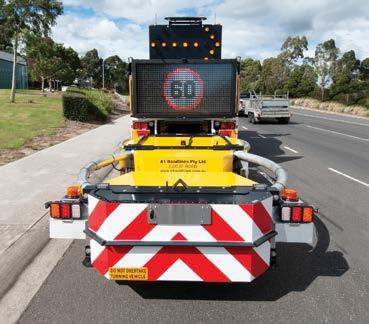




NO RELIANCE ON ROLL-AHEAD DURING AN IMPACT
Rather than relying on some of the impact energy being absorbed by the forward movement of host vehicle on which the TMA is fitted, with ‘Infinity Testing’ the host vehicle is anchored to the ground to prevent any forward movement during an impact.

‘WORST CASE’ SCENARIO TESTING
Compared to standard testing with an unrestrained host vehicle, Infinity Testing is a much tougher testing regimen. It is considered ‘worst-case scenario’ testing which makes it much more difficult to meet the pass criteria for IS values, as all of the Ridedown Acceleration must be provided by the TMA absorbing the energy from the impact.

TMA ABSORBS & DISSIPATES 100% OF THE IMPACT ENERGY Testing the TMA on a host vehicle which is anchored in place, tests – and for both the Scorpion II® TL-3 and Scorpion® II METRO® TL-2 TMAs – confirms the capacity of the TMA to absorb/dissipate 100% of the impact energywithout the benefit of the host vehicle roll-ahead.
NO UPPER LIMIT FOR HOST VEHICLES
From a practical standpoint, the fact that both the Scorpion II® TL-3 and Scorpion® II METRO® TL-2 TMAs were successfully tested to MASH Standards using the ‘Infinity Testing’ method, means both units are MASH certified with no upper weight limit for the host vehicle.
www.a1roadlines.com.au
HOW IT’S DONE
With ‘Infinity Testing’ the host vehicle is anchored in place during the impacts to assess the TMA's capacity to absorb/ dissipate 100% of the impact energy without the benefit of roll-ahead.

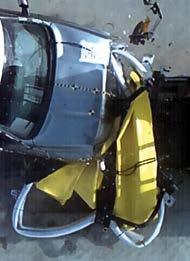
WHAT ABOUT ROLL-AHEAD DISTANCES?
Importantly, to emulate ‘real world’ operating conditions, both the Scorpion II® TL-3 and Scorpion® II METRO® TL-2 TMA have also been successfully tested and MASH certified using standard ‘non-anchored’ host vehicles, with both units posting impressively low roll-ahead distances.
Scorpion® II TL-3 TMA
Crash Test: MASH Test 2-53
Impacting Vehicle Weight: 2266kg
Impact Angle: 10.3 Degrees Impact Speed: 103.8km/h
Roll-Ahead Distance: 5.1m
Scorpion® II METRO® TL-2 TMA
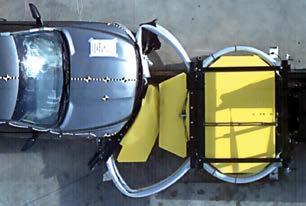

Crash Test: MASH Test 2-53 Impacting Vehicle Weight: 2295kg


Impact Angle: 9.9 Degrees Impact Speed: 81.6km/h
Roll-Ahead Distance: 12.4m
ULTIMATE
THE EQUIPMENT YOU NEED – THE SERVICE YOU EXPECT A1 Roadlines Pty Ltd | 89 Rushdale Street, Knoxfield, Victoria 3180 P: 1300 217 623 (A1ROAD) | E: sales@a1roadlines.com.au
THE
TEST OF ATTENUATOR PERFORMANCE
CASE STUDY CASE STUDY
INTRODUCTION
Following the launch of Master Builders Solutions’ revolutionary MasterSuna® RCT 323 product in Australia in November 2021, numerous trials have been conducted across Australia to show how the product performs in treating returned concrete. A number of these trials have focused on the reuse of treated concrete back into a concrete mix as a sustainable option for the industry to ‘close the loop’ on returned concrete and prevent wasteto-landfill.
In May 2022, Master Builders Solutions, together with one of its valued customers in Western Australia, decided to conduct a fullscale trial encompassing the entire process from start to finish, including treating the returned concrete and introducing the treated material back into a fresh concrete mix as a partial coarse and fine aggregate replacement at a range of percentages of total aggregate. The trial demonstrated how treated material
was reintroduced, as well as the cost savings associated with purchasing aggregates, haulage and dumping.
Importantly, even though it is difficult to accurately calculate and extrapolate reductions in C02(e) emissions in a trial of this size at one location, it is clear from the savings in materials, disposal and transport, that use of MasterSuna® RCT 323 recycled aggregate will not only deliver significant cost savings but will also result in a significant reduction in C02(e) emissions for most, if not all, users.
TREATING THE RETURNED CONCRETE

On May 3rd 2022 at 2pm, the team treated approximately 2.4m3 of unwanted ready-mixed material returned from a concrete pour. Three bags of the MasterSuna® RCT 323 product were added to the agitator drum of the concrete truck to complete the treatment. The process took approximately 3-minutes of mixing from the addition of RCT 323 product.
Once the material had granulised, it was discharged from the agitator onto a suitable hardstand area in order to avoid crosscontamination with other aggregates, while also leaving sufficient space for the materials to be accessed with a front-end loader.
Once the treated loaded had been fully discharged from the agitator, the piles of treated material were back-bladed to a height of approx. 150mm and left to dry out overnight, ready for remix and break up the material the following morning. The Agi bowl was later inspected at the slump stand to see if any material had remained in the bowl. As all material has successfully discharged, it was determined that the agitator would not have to be washed out after the material treatment. This not only leads to quicker turnaround times for reloading agi’s, it also helps to minimise the risk of additional water in the bowl after wash-out.
At 7am the following morning, the material was re-mixed with the front loader in order to
Using MasterSuna RCT 323 recycled aggregate in new concrete 26 Construction Engineering Australia • November 2022
free up the material and prevent balling. If balling occurs, the loader bucket can be utilised to flatten the balls by back-blading. The operator can also use the wheels of the loader to roll-over and break up the material if required.
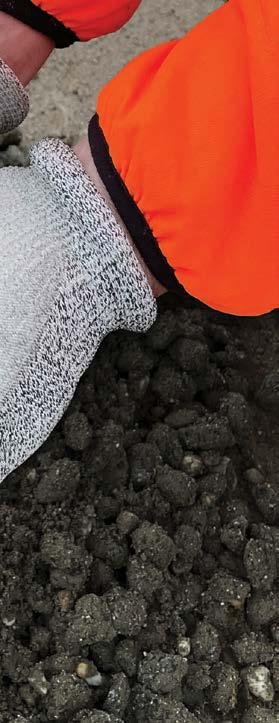
Once this has been completed, the material can be stockpiled and should remain free from binding together or balling as the hydration process has completed and the material will not re-hydrate.

LAB TRIALS – GATHERING DATA
Prior to any full-scale trials being carried out, initial lab trials should be conducted to provide initial data to create a mix design replicable to the control mix. Always carry out PSD, Particle Density and Water Absorption testing on the treated materials. This will provide data in order to create a suitable mix design to optimize the aggregate replacement and will allow you to calculate the theoretical yield and free water cement ratio.
FIELD TRIALS
On the 4th May 2022, full-scale plant trials were conducted using a mix incorporating 15% of treated RCT 323 material. Prior to dosing the material, moisture tests were carried out to ensure
that any water in the material was captured and taken into consideration prior to batching. The RCT 323 materials was also re-mixed prior to use to ensure that it was free-flowing and completely free of any significant lumps.
Table 2 – Control vs. 15% RCT 323 aggregate replacement mix


 Figure 1 – Strength Development for 20MPa footing using a mix with 20% RCT 323 aggregate replacement
Table 1 – Mix characteristics using 20, 30 and 50 per cent RCT 323 aggregate replacement
Figure 1 – Strength Development for 20MPa footing using a mix with 20% RCT 323 aggregate replacement
Table 1 – Mix characteristics using 20, 30 and 50 per cent RCT 323 aggregate replacement
Construction Engineering Australia • November 2022 27 CASE STUDY
A 20MPa footing mix was chosen for the trial. Both fine and coarse aggregate was replaced based on past PSD information gathered. Due to the cementitious material present, there was an increase in fines passing the 75mic sieve which allowed for the reduction of fine aggregate.
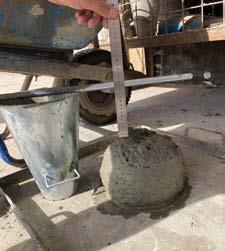
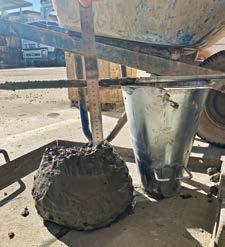
The pour consisted of 25m3 for a residential footing. This enabled the team to sample an initial 5m3 from the control mix for comparative data. Mid-way through the pour the team batched 5m3 of the RCT 323 mix. A visual inspection of the mix from the slump stand showed there was no noticeable difference in terms of workability between the RCT 323 mix and the control mix. A sample of the RCT 323 mix was taken at the plant in order to carry out initial type testing for slump, air content and compressive strength and subsequent testing at 7 and 28 days.
Both mixes left the site at 130mm slump due to the long transit. The Control and RCT mix both looked identical in terms of workability and finishability, while the rheology within the RCT 323 was improved due to the addition of cementitious particles in the matrix.
The pour was located 45 minutes away from the plant, which provided a good test for slump retention. No water was added on site and no negative feedback was recorded from contractors. If fact, the contractors did not notice any difference between the two mixes.
COMMERCIAL BENEFITS

Using mixes incorporating MasterSuna® RCT 323 recycled aggregate delivers a number of significant commercial and environmental benefits, including:
• Reduction in aggregate purchases from external suppliers (treated concrete has been paid for and being re-used)
• Trucks not diverted to landfill or quarries to have returned concrete dumped – saving in fuel and truck turnaround. Treated in the concrete yard and re-used as an aggregate.
• Saving in water usage due to washout not required after treatment. Also contributes to less build-up of waste in washout pits which ends up in landfill.
• Front-end loader is fully utilized for concrete production and not tied up reloading pit waste into tippers.
• Saving on maintenance of machinery
• Tippers carting aggregates and utilised for other sales over carting waste (which usually requires tipper bodies to be washed out resulting in reduced availability).
• Quarries becoming full of concrete waste, resulting in non-productive time for crushers crushing waste over virgin aggregates.
• Reduction in waste-to-landfill.
COST BENEFITS – DISPOSAL VS. TREATING WITH RCT323
Using mixes incorporating MasterSuna® RCT 323 recycled aggregate delivers significant cost benefits when compared to traditional mixes:
REDUCTION IN C02(E) EMISSIONS
As noted previously, while it is difficult to accurately calculate and extrapolate reductions in C02(e) emissions in a trial of this size at a specific location, it is clear from the savings in materials and disposal costs, as well as the reduction in material transport (kg/km), that use of RCT 323 MasterSuna® RCT 323 recycled aggregate will deliver a significant reduction in C02(e) emissions for most, if not all, users when compared to traditional mixes.
For further information on MasterSuna® RCT 323, please Scan the QR Code or contact your local Master Builders

Solutions technical specialist on: (Australia) Freecall: 1300 227 300 or (New Zealand) Freecall: 0800 334 877.
Table 3 – Cost of dumping returned concrete vs. treating with RCT323
 Figure 2 - Control Mix
Figure 2 - Control Mix
Figure 3 - 15% RCT 323 aggregate replacement mix
28 Construction Engineering Australia • November 2022 CASE STUDY
* PLEASE NOTE: Dollar values are indicative only and included for the purposes of this case study. Actual costs and data will vary for each state and each individual company. This case study was carried out in Western Australia.






Manage your construction operations more safely and more productively using less space with Combilift’s materials handling solutions combilift.com/?cea Safety Storage Efficiency • Sa fer product handling • Op timised production space • Impr oved storage capacity • Incr eased productivity & output • Enhanced profits
Transition Test #1 for 2270kg Ute
Transition Test #2 for 2270kg Ute
Transition Test #1 for 13,000kg Bus
Transition Test #3 for 2270kg Ute
The DOLRE bridge tra c barrier development demonstrates how the incorporation of FEA into the design process can optimise a solution that is vastly di erent from the solutions that traditional Engineering methodologies would produce.
Transition Test #1 for 900kg Sedan



A problem was identified and through the iterative use of FEM combined with Eurocodes for structural analysis a solution was found and optimised that was vastly di erent to the direction that traditional engineering was leading.
Once the bridge barrier design was optimised, the same process was used to assess transition designs to various European roadside barriers in accordance with EN1317 and TR16303-2011 requirements.

Australian authorities required product assessment to Australian bridge standards. Future finite element modelling in accordance with MASH standards and NCHRP179 validation requirements satisfied ASBAP’s analysis for both tra c barrier and transition designs.










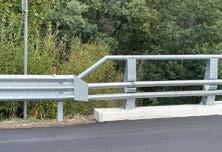

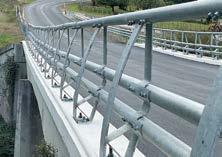
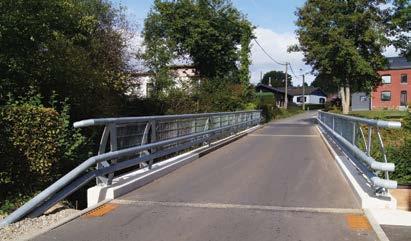
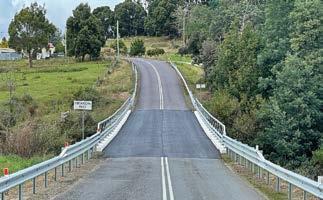








www.lbaustralia.com.au Ph 1300 522 878 • Fully crash tested to European Standards and simulated to US MASH TL4 requirements • Unique design imparting low stress to bridge deck - protecting water proofing membranes and coatings on the deck • Easy to install • Easy to dismantle in times of flood • Cost-e ective bridge rehabilitation solution Ideal for Bridge Refurbishment Projects. ASBAP Approved for use in Australia DISCOVER MORE
DODGE CONSTRUCTION NETWORK REPORT IDENTIFIES KEY OBSTACLES FOR SUBCONTRACTORS
Dodge Construction Network’s 2022 Top Business Issues for Specialty Contractors Report highlights how digital transformation can help alleviate challenges for the construction industry, including the labour shortage, supply chain, materials financing, safety, rework and communication on projects

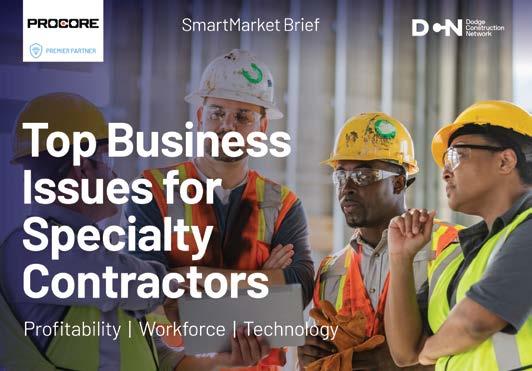
In partnership with Procore Technologies, Inc., a leading global provider of construction management software, Dodge Construction Network recently released the results of its 2022 Top Business Issues for Specialty Contractors Report. This report highlights key issues impacting subcontractors, including workforce management, technology and profitability to help businesses better understand recurring trends while broadening industry awareness of the advantages that can be created by leveraging digital solutions.
This global research was completed by five types of subcontractors: mechanical, electrical, plumbing, steel and concrete. Key findings include:
• Labour shortage and supply chain will continue to afflict the industry: Research found that over 90 percent of subcontractors report their projects have been negatively affected by a shortage of skilled labour. Experts anticipate the current shortage to worsen. Research has shown that on average, 33 percent of the current workforce is likely to retire in the next five years.
The labour shortage, alongside supply chain disruptions, is having a significant impact on the industry. About one third of subcontractors (31%) cannot pass materials
cost increases on to owners on half or more of their projects. This is highest among steel contractors (43%), who face an extremely volatile cost market.
32 Construction Engineering Australia • November 2022 SPECIAL REPORT
• Rework is significantly impacting profit margins: Subcontractors identify poor resource management (ie: labour, materials, equipment) and poor client communication as top drivers of rework. Poor resource management often drives unplanned rework, which is a key drain on productivity, schedule management and cost control. In addition to that, unbillable change orders represent major lost revenue, especially for larger companies.
On average, 30% of project revenue is lost because of unbilled and unpaid change orders, according to survey respondents.
To counter the negative impact of labour shortages, subcontractors most frequently cite construction technology investments to improve productivity.
• Leveraging construction technology can help alleviate some of the industry’s most pressing challenges: On average, subcontractors report that 20% of workers’ time is currently spent on lowproductivity tasks, such as tracking down information or documenting information on paper.

According to the report, an average of 39% of respondents state they still primarily use whiteboards, spreadsheets and other outdated processes. This lack of standardised processes hurts fieldto-office communication, negatively impacting the effectiveness of key project processes.
“The challenges specialty contractors are facing today, highlight the need for a connected platform built to address their needs,” said Will Lehrmann, head of product, specialty contractors, at Procore.
“Several key takeaways from this research show that the power of technology can help improve productivity and efficiency—as well as combat the workforce and skill shortages—that many
specialty contractors are still facing,” Mr Lehrmann added.
In order for contractors to advance and evolve to meet the needs of their clients, the report suggests company leaders must identify where inefficiencies are present within their organisations and adopt more dynamic technological solutions to address them.
Best practices for technology evaluation and implementation include:
• Identifying needs before evaluating options
• A phased roll-out plan
• A structured process for engaging key stakeholders
• Metrics to determine success
“Specialty trade contractors are vitally important to the construction industry”, says Steve Jones, senior director of industry insights research for Dodge Construction Network.
“Dodge and Procore partnered on this research so these companies can better understand how their peers are performing and what could improve their critical outcomes.”
“We sincerely hope these insights will help them operate more safely, efficiently and profitably,” Mr Jones added.
A copy of the report is available for download at: https://www.procore.com/en-au/ ebooks/top-business-issues-for-specialtycontractors
ABOUT DODGE CONSTRUCTION NETWORK
ABOUT THE DATA
The Top Business Issues for Specialty Contractors
SmartMarket Brief is the latest in a series of research reports published by Dodge Data & Analytics on how economic trends, workforce issues and technology advances are transforming the global construction industry and affecting the individuals and organizations that operate in it.
This report focuses exclusively on five types of specialty trade contractors (mechanical, electrical, plumbing, steel and concrete). It examines the top issues they are facing related to profitability, workforce resources and adopting and implementing technology.
This is a global research study, covering the US, Canada, UK and Australia/New Zealand. Dodge recognizes a wide variety of construction-related terminology is used across these regions. To avoid redundancy, the report defers to the terminology most commonly used in the United States.
To provide a comprehensive perspective, survey respondents include companies that range from the local equivalent of $2 million to over $2 billion (USD) in annual construction volume. For analysis purposes in the report, these are grouped into four categories:
• Small companies: $2 million to under $10 million
• Medium companies: $10 million to under $50 million
• Large companies: $50 million to $200 million
• Very large companies: Over $200 million
In certain cases throughout this report, the findings from two size categories are added together for simplicity into an aggregated group such as large/very large companies or small/ medium companies.
The Report data sources include 32% of respondents from the United States, 23% from the United Kingdom, 23% from Canada and 22% from Australia and New Zealand.
ABOUT PROCORE
Procore is a leading global provider of construction management software. Over 1 million projects and more than US$1 trillion in construction volume have run on Procore's platform.
Procore’s platform connects key project stakeholders to solutions Procore has built specifically for the construction industry—for the owner, the general contractor, and the specialty contractor. Procore's App Marketplace has a multitude of partner solutions that integrate seamlessly with Procore’s platform, giving construction professionals the freedom to connect with what works best for them.
Headquartered in Carpinteria, California, Procore has offices around the globe. Learn more at: https://procore.com
Dodge Construction Network leverages an unmatched offering of data, analytics, and industry-spanning relationships to generate the most powerful source of information, knowledge, insights, and connections in the commercial construction industry. The company powers four longstanding and trusted industry solutions
— Dodge Data & Analytics, The Blue Book Network, Sweets, and IMS — to connect the dots across the entire commercial construction ecosystem. Together, these solutions provide clear and actionable opportunities for both small teams and enterprise firms.
Purpose-built to streamline the complicated, Dodge Construction Network ensures that construction professionals have the information they need to build successful businesses and thriving communities. With over a century of industry experience, Dodge Construction Network is the catalyst for modern commercial construction.
Construction Engineering Australia • November 2022 33 SPECIAL REPORT
Australian engineered solar tiles make their global debut

Leeson Group, a diversified group of Australian renewable energy companies, recently announced the global launch of Volt, an Australianengineered roof solar tile.
The launch of Volt coincides with the appointment of Bristile Roofing as the roofing partner of Volt in Australia and La Escandella, the world's largest terracotta roof tile manufacturer as its global distributor outside of Australia, opening new export opportunities for Volt to be sold in 85 countries including Spain, United States, United Kingdom and Germany.
Volt solar tiles integrate with Bristile Roofing’s Terracotta Planum (La Escandella), and concrete Prestige, Premiere and Eton profiles. With Bristile Roofing holding a significant market share for new home roofing products in Australia, and globally La Escandella distributing roof tiles for over 50,000 homes per year, this will provide Volt with an initial potential market of 250MW annually.
Using a unique Metal Wrap Through (MWT) cell technology and a busbar-free design to increase the efficiency of solar cells, Volt solar tiles creates a seamless look on rooftops when installed with its all black components and a safer built-in interlocking cable containment system.
The Volt Planum and Lodge solar tiles are the world’s first solar tiles that can generate the equivalent amount of energy as a standard solar panel. The 115W MWT mono PERC Planum module has a market-leading 18.8% solar efficiency and the Volt Lodge solar tile 105W MWT mono PERC module has a solar efficiency of 19.4%.
Peter Leeson, Managing Director of Leeson Group, Founder and Director of Volt Solar Tile said, “Australian engineered solar technologies are highly regarded around the world and recognised for their innovation and quality. Our partnership with Bristile Roofing and La Escandella will allow us to expand our market share in the solar tile industry. In the future, Volt solar tiles will be Australian made as we are planning to manufacture our solar tiles in Australia and to produce them at a competitive price.”
“Volt solar tiles are a quarter the cost of its competitors' integrated solar roofs and half the cost of other solar tiles systems. A 5kW Volt system costs $12,000 fully installed after STC rebates,” he said.
“With Volt, we’ve made solar tiles affordable and accessible for homeowners who want clean and affordable energy to power their homes,” Peter Leeson added. “At the same time, Volt meets the aspirations of homeowners who want to invest in a quality and sustainable rooftop solar system that is safe and built to last in the harsh climate conditions that we face.”
Scott Kind, Commercial Manager of Bristile Roofing said, “The design of a Volt solar tile creates a more elegant and streamlined look for modern homes. With Volt, we’re giving homeowners the option to bring clean energy to their homes together with a wide range of beautiful Bristile Roof tiles at an accessible cost.”
Alfred Vincent, General Manager of La Escandella said, “Volt will turn the roofs of new homes into renewable energy power stations. La Escandella manufactures the world’s highest quality terracotta roof tiles and our partnership with Volt aligns with our quality roof tiles and our values.”
“We are excited to offer Volt globally to our market of over 50,000 homes as Volt has developed a high-quality Australian engineered rooftop solar system that is built to last,” Mr Vincent added.
Weighing just 10 kilograms, Volt is lighter than a standard solar panel and roof tile and requires less building materials to support its installation. This translates to a more sustainable rooftop solar system as fewer emissions are created with the building of a new home. Volt is TUV certified and is currently awaiting certification from the Clean Energy Council for its approved product list. It is backed with a 30-year performance warranty and 15-year product warranty.
For further information on the Volt Partnership Program, visit: https://www.volt-tile.com/volt/solar-tile-product-info-request
34 Construction Engineering Australia • November 2022 INNOVATIVE SOLUTIONS
C M Y CM MY CY CMY K


Master X-Seed® 1500 hardening/accelerating admixture can be used in both concrete and shotcrete applications and is designed to boost the hydration process of early-age cement. It delivers a range of benefits: 1) 50% Faster Concrete Hardening 2) 10% Reduction in CO2 Emissions 3) Increased Utilisation of SCMs 4) Increased Early and Late-Age Strengths 5) Earlier Stripping & Reuse of Formwork 6) Design More Complex Forms Sustainability + Performance = Master X-Seed® 1500
materials.
Call us today on 1300 227 300 or SCAN the QR CODE to find how the concrete industry is utilising Master X-Seed® across Australia and New Zealand to reduce their carbon outputs and minimise their extraction of virgin, raw
COMPLIANCE MADE EASY
The significant growth in major infrastructure and construction projects which has occurred in recent years – together with the associated growth in demand for construction materials –has also resulted in an increased chance of inferior products and materials finding their way onto construction sites in place of materials which conform with the relevant Australian and New Zealand Standards. As such, matters relating to product conformity and certification of construction materials such as structural and reinforcing steels to Australian and New Zealand Standards is perhaps now more important than ever before.

PRE-QUALIFICATION OF ACRS STEEL MAKES COMPLIANCE WITH AS/NZS STANDARDS EASY
36 Construction Engineering Australia • November 2022 ACRS FEATURE
Ensuring that the construction steels being used throughout all stages of construction or fabrication conform with all relevant Australian and New Zealand Standards and Building Codes - irrespective of their country of origin - is of paramount importance. After all, these Standards have been considered and developed to ensure that buildings and other structures are not only ‘fit for purpose’, but are also capable of meeting their design life requirements.
Unfortunately, in this day and age, it’s simply not enough to think that just because steel has been ordered to an Australian or New Zealand Standard that the delivered product will automatically conform with that Standard and be fit for purpose. Increasingly, this is not the case. In fact, there are some instances where even though the materials have been specified and ordered to an Australian Standard, the materials that arrive are non-conforming. The product may meet the Standard; it may be supplied with documents for “an equivalent Standard” (but which Standard and is it really equivalent?) or it may not meet any Standard at all.
Importantly, whether this non-conformance is an intentional act of deception or 'counterfeiting' on behalf of the materials supplier, the builder or the contractor; or simply a matter of non-conformance through lack of correct process or an innocent misunderstanding of what constitutes conformance with Australian Standards, is effectively a moot point. Using non-conforming building materials carries a high risk of 'built-in' failure - the results can be disastrous.
INDEPENDENT, EXPERT, THIRD-PARTY CERTIFICATION
The only way to be truly sure that the materials being used conform fully with the appropriate Australian and New Zealand Standards and are fit for purpose, is through independent, expert third party certification with ongoing validation.
ACRS provides a fully independent, expert assessment and certification to AS/NZS Standards for both Australian and internationally sourced construction steels, including reinforcing steels, structural steels and prestressing steels.

ACRS steel is pre-qualified. The manufacturers and processors have already demonstrated compliance with the relevant Australian and New Zealand Standards.
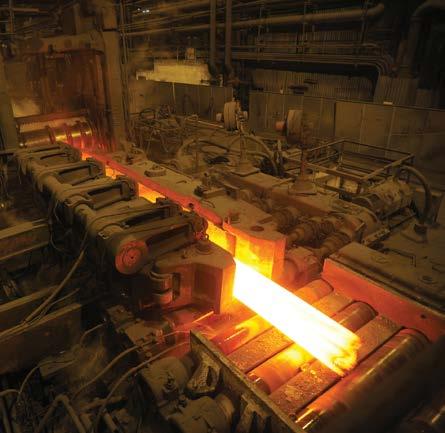
By using ACRS certified construction steels, builders and contractors can be confident that they are getting the AS/NZS compliant materials that they ordered, and engineers and building certifiers can be confident that the steel meets the requirements of the Building Codes and associated Standards and is fully traceable from the point of manufacture to the point of delivery.
All ACRS certification personnel are fully-qualified metallurgists and engineers with many years of direct experience in the manufacture, processing, or design and construction of the steel materials it certifies. In addition to factory production control audits and independent testing, the ACRS scheme provides regular review and analysis of all products manufactured and supplied by the certified supplier. All testing is observed and verified by independent NATA test laboratories, and all processes, including the use of traceability tags, are audited.
The ACRS scheme operates as a verification-based system modelled on international best-practice standards. Where some certification systems might accept the suppliers’ own quality management systems certification and test reporting without further checking, ACRS doesn’t. ACRS assessors independently select the samples for testing during the audit to prevent any chance of “cherry picking” by the supplier. It then manages the subsequent verification process though independent qualified laboratories selected by ACRS, not the supplier.
The process is further bolstered by ACRS conformity checking on the suppliers’ raw production data, which is undertaken every three months.
Construction Engineering Australia • November 2022 37 ACRS FEATURE
ACRS MAKES IT EASY
Perhaps most importantly, ACRS certification makes checking for compliance with the relevant Australian and New Zealand Standards easy. It demonstrates
INDEPENDENTLY and EXPERTLY that the supplier consistently meets the Standards stated on the certificate.
Beyond checking the supplier’s ACRS certificate, product markings and tags, there’s no need for you to make any further checks on ACRS certified materials. That means:
• No more checking materials properties against technical specifications;
• No more checking batch numbers against the test certificates.
This makes matching material to conformity documentation simple and effective for the customer and for any verifier.
The ACRS website also forms an integral part of the process of verification of supply claims and helps to protect against fraudulent certification claims. Visitors to the website (www.steelcertification.com) are able to search for all current ACRS certified suppliers by location (globally) and/or product category.
Search results include a full listing of all certified suppliers for the selected criteria, detailing: company name; location, certification status and certificate number.
The certificate number also provides a hyperlink to a PDF version of the current certificate. Most entries also contain additional hyperlinks which provide visual details of product markings, together with a scanned example of an actual product tag from the supplier.
The bottom line... with ACRS it’s easy for your suppliers, easy for your customers and easy for you!
For further information please email ACRS at: info@steelcertification.com or visit the website: www.steelcertification.com
HOW DO I SPECIFY ACRS CERTIFIED STEELS?

The easiest way to manage and minimise the risk of non-conforming construction steels, is to specify ACRS certified steels.
SUGGESTED WORDING FOR STRUCTURAL STEELS
“Structural steels shall comply with AS 1074, AS 1442, AS 1579, AS/NZS 1163, AS/NZS 1594, AS/NZS 3678, AS/NZS 3679.1, or AS/NZS 3679.2, as appropriate. Structural bolts shall comply with AS/NZS 1252.
Where applicable, materials shall be fabricated in accordance with the “Fabrication” requirements in Section 14 of AS 4100 or Appendix G of AS 5100.6, or AS/NZS 2327, or NZS 3404, and the requirements of AS/NZS 5131.
Acceptable manufacturers of structural steels, structural bolts, and the fabricators of structural
Just because your supplier was previously ACRS Certified, don’t take it for granted that they still are. Their ACRS Certification status may have changed due to factors including:
Changes in ownership > Changes in manufacturing locations
That’s why ACRS’ comprehensive program of annual audits and rigorous 3-monthly data analysis is so important. It ensures that standards and quality are maintained, so you can have
confidence in your construction steel supplies.
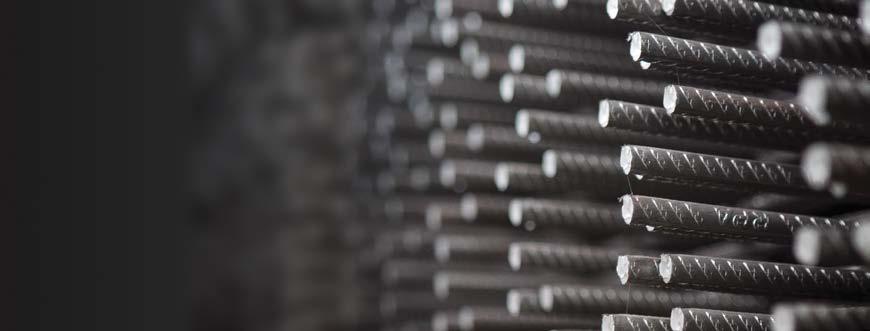
Importantly, checking and confirming that ACRS certificates for products/suppliers are current is quick and easy on the ACRS website.
Visit: www.steelcertification.com for full details of all current certificates.
WWW.STEELCERTIFICATION.COM
STAY UP-TO-DATE AT
> Additional
> Discontinued
>
products
Products
38 Construction Engineering Australia • November 2022 ACRS FEATURE
welded sections must hold a valid certificate of approval issued by the Australasian Certification Authority for Reinforcing and Structural Steels Ltd (ACRS), or to such other accredited product certification system as shall be demonstrated by the supplier to be directly equivalent in scope and technical rigour to ACRS and approved as such in writing by the specifier.

Evidence of the supplier’s compliance with this clause must be obtained when contract bids are received.”

SUGGESTED WORDING FOR STEEL REINFORCING MATERIALS
“Steel reinforcing and steel prestressing materials for concrete shall comply with AS/NZS 4671 or AS/NZS 4672, respectively.
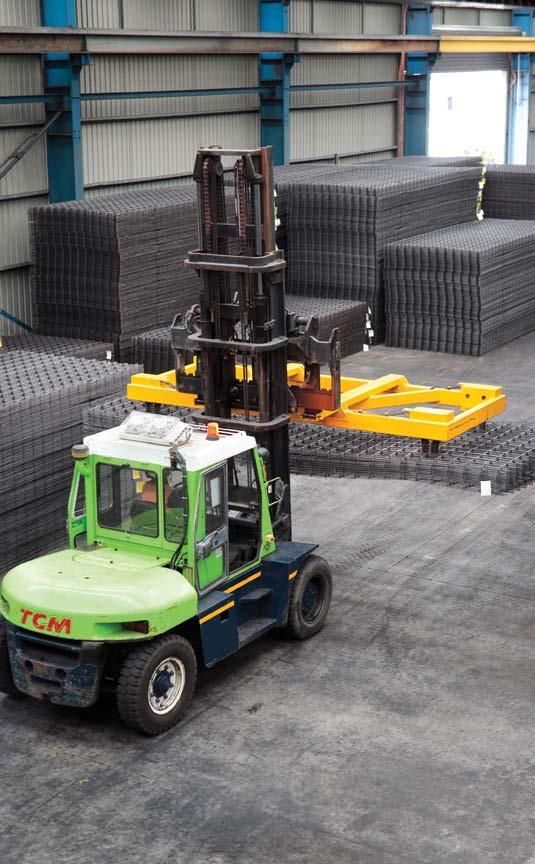
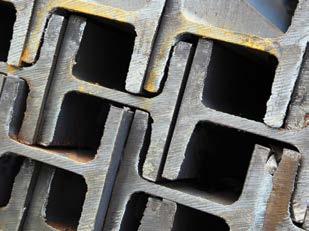
Where applicable, materials shall be cut and bent in accordance with the requirements of the "Material and Structural Requirements for Reinforcing Steel" clauses in AS 3600 or AS 5100.5, or the “Reinforcement” clauses of NZS 3109.
Reinforcing couplers shall comply with RMS specification RMS SF2013/184115 Approval of Mechanical Reinforcing Bar Splices, or NZTA SP/M/022 Bridge Manual (technical approval sections), as specified.
Acceptable manufacturers and processors of steel prestressing and steel reinforcing materials, including both manufacture and application of reinforcing couplers, must hold a valid certificate of approval issued by the Australasian Certification Authority for Reinforcing and Structural Steels Ltd (ACRS), or to such other accredited product certification system as shall be demonstrated by the supplier to be directly equivalent in scope and technical rigour to ACRS and approved as such in writing by the specifier.
Evidence of the supplier’s compliance with this clause must be obtained when contract bids are received.”
The bottom line... with ACRS it’s easy for your suppliers, easy for your customers and easy for you! Construction Engineering Australia • November 2022 39 ACRS FEATURE
THE CONSTRUCTION SECTOR’S APPROACH TO THE IMPLEMENTATION OF DIGITAL TECHNOLOGIES
by Rob Bryant, EVP of APAC at InEight
Last year’s inaugural InEight Global Capital Projects Outlook (GCPO) found the construction industry was bullishly optimistic about its future, despite the shortcoming that arose from the pandemic. And while the construction sector faces further economic, labour and logistical challenges in 2022, this year’s GCPO report revealed there is ongoing industry confidence as 94 per cent of APAC project owners and contractors are optimistic about their company’s future.
It is important to acknowledge that the survey participants represent project owners and top to mid-tier contractors and consultants.
At the centre of this positive sentiment is the industry’s stance on digital technologies with nearly two-thirds of APAC respondents citing this to be their organisation’s biggest growth opportunity for the year ahead.
GROWTH OPPORTUNITIES IN THE SECTOR
Today, the environment in which construction and engineering projects are delivered is very different from what it was 20 or even 10 years ago. That is true in commercial, social, technological, and
climatic senses. Yet, even when technology is utilised, projects are often planned and managed in essentially the same way they were decades ago. The sector is at a critical point in its lifecycle, and as the GCPO report indicates, the effective application of technology is anticipated by many to have a significant role in the sector’s evolution.
In fact, data analytics (55%), building information modelling (50%) as well as artificial intelligence and machine learning (45%) are the types of technologies project owners and contractors reveal being the most critical for their organisation’s success in the next 1-3 years.
As capital projects become more complex due to external factors, the reliance of such technology is necessary because it connects data points together. Connected technology creates a collaborative atmosphere for all stakeholders, maximises project transparency and bridges common data gaps to ultimately provide higher levels of project certainty.
In relation to project certainty, the GCPO report found 20 per cent of respondents revealed their organisation completes construction projects on or ahead of the original schedule 80 to 99 per cent
of the time. When looking at how often construction projects were completed on or under budget, just 18 per cent claimed to do so up to 80 to 99 per cent of the time.
At 57 per cent, inadequate communication - whether that be with stakeholders or construction workers on site - was cited as the biggest challenge for organisations completing projects on time and on budget.

Considering the industry sights technologies as a major factor for progression and the anticipated provision of a competitive edge, there is often a disconnect between the implementation and adoption of these technologies to achieve project certainty. This prompts the question – what are the issues of technology implementation in construction?
ADDRESSING ISSUES OF TECHNOLOGY IMPLEMENTATION
The GCPO report reveals 40 per cent of project owners and contractors claim “there is room for improvement” regarding the implementation process with over half experiencing insufficient training on new tools as a roadblock during the change management process.
Considering project teams, site workers, consultants and project owners have varying levels of engagement and experience with technologies, it is important to offer different kinds of training. This can be in-person training, asynchronous webinars, live demos, or e-learning. Making learning flexible in timing and format is essential for the project workforce of today.
Digital adoption and process change can be expensive. Having technology transformation owned and driven by executive leadership is essential. And an understanding of the investment necessary is essential to success. A Gartner Survey in 2018 revealed that the construction sector was the least accurate in estimating the difference between expected and actual investment in emerging tech, with a 45 per cent delta (healthcare was top at just 6 per cent difference).
Project owners and contractors must understand the role they play in supporting the efforts of change and transformation within the industry. As such, having an eye on the future won’t only drive adoption, investment and change today, it will also buy a ticket to the game tomorrow.
40 Construction Engineering Australia • November 2022 DIGITAL TECHNOLOGY
EBAWE designs, engineers and installs complete production plants for the manufac ture of the most varied precast concrete panels. We are the ideal partner for your projects –regardless of size and kind.

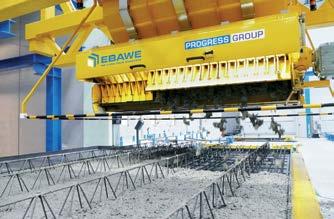
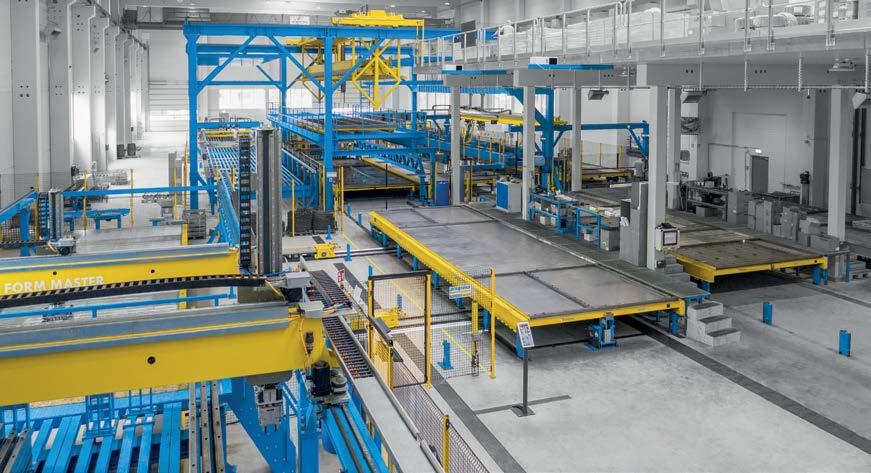
www.ebawe.de Highly automated carrousel plants Customized solutions Excellent precast products Complete solutions from a single source
COBURG STATION PART OF AWARD-WINNING PRECINCT
A stunning precast concrete façade that adds depth to the landscaped site and exemplifies the changing daylight conditions, has contributed to the project winning a highly sought-after Victorian Government award.
Coburg Station – with its precast façade manufactured by National Precast Master Precaster Advanced Precast – is a part of the Bell to Moreland project in Melbourne’s north. The project is a part of the Victorian Government’s Level Crossing Removal Project and was recently awarded a key prize at the Victorian Premier’s Sustainability Award 2022.
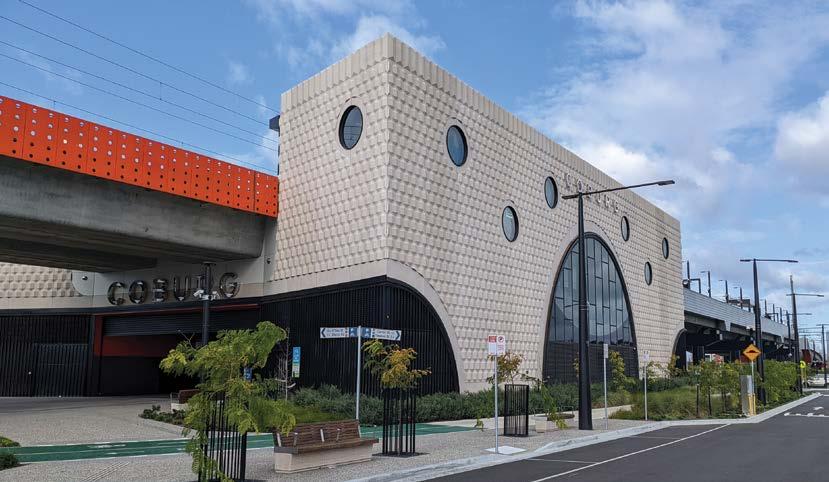
The recently completed project has been awarded the Industry Leader Award in the Premier’s Sustainability
Awards – Sustainable places and destinations category.
As a part of the Project, four level crossings were removed, two kilometres of rail between Bell Street (Coburg) and Moreland Road (Brunswick) were elevated and two new stations were built at Coburg and Moreland. In addition, 2.5 kilometres of open space were created to encourage active transport, innovative landscaping to encourage biodiversity, and co-design for better place-making.
The new Coburg Station features a stunning diamond-stamped façade manufactured with a white oxide mix. Advanced Precast has implemented the use of custom form-liners to achieve the complex embossed façade panels for the building.
Designed by Project architect Wood Marsh, the textured façade changes the building’s appearance as it highlights the differing light conditions throughout the day as the sun angle changes. The panels breathe new light into the space, offering a bright and welcoming appearance to commuters.
The Bell to Moreland project incorporates a variety of sustainable features such as energy and water monitoring systems, solar panels at Coburg Station, water-sensitive urban design, and Woody Meadows planted with Australian natives. It is also the first train station in Australia to be awarded a six-star green star rating by the Green Building Council of Australia (GBCA).

One of National Precast’s newest Industry Partners, Italian company Progress Group has collaborated with design studio studiooberhauser to use 3D concrete printing for its award-winning CHAIR N°ONE design project.
According to National Precast’s CEO Sarah Bachmann, the peak body for the Australian precast industry is delighted to join forces with one of Europe’s leading precast 3D software developers.
“That Progress Group is winning international awards is testament to the company’s recent involvement by becoming an Industry Partner member”, says Ms Bachmann.
The award-winning piece is not just a piece of furniture but a piece of art, and was conceived in
PRECAST 3D PRINTED CHAIR WINS BEST OF THE BEST IN SINGAPORE Image: ©2022 Andreas Senoner Photography 42 Construction Engineering Australia • November 2022 NATIONAL PRECAST NEWS
absolute freedom of form, something that could only be realised with a 3D printing process that was enabled by Progress 3D Innovation.
So much so, that the project has been awarded a Best of the Best “In search of good design” prize at the renowned international product design awards Red Dot. With a history of more than 60 years long, the annual design competition is known for awarding its indistinguishable “Red Dot” which has become highly sought after as a seal of quality for good design.
Out of approximately 4,000 international submissions, only 38 were awarded the Red Dot: Best of the Best prize. The project impressed with its innovative design and absolute freedom of form at one of the largest design competitions in the world.
The chairs are printed in one piece, which provides structural stability and a continuous surface. The selective cement activation process gives the concrete its own language and immediately connects the user with the object as it radiates simplicity, purity and essentiality.
KEEPING PRECAST CLEAN JUST GOT EASIER
A new range of revolutionary coatings that mimic how Mother Nature self-cleans surfaces, are now available from National Precast Supplier member ECOTONE.
Longstanding member ECOTONE – previously known in Australia as Nawkaw – has been supplying staining products to the precast industry and has extended its product range to include protective coatings with multiple environmental benefits.
National Precast CEO Sarah Bachmann says that the company’s new product line ECOCLEAN offers functional benefits to precast both internally and externally. Internally, the products clean surfaces to reduce Sick Building Syndrome and purify the air we breathe. Externally, they have self-cleaning properties to reduce cleaning, maintenance and replacement costs. By protecting against carbonation they also preserve the as-new look of the precast. Precast concrete with these coatings also helps to reduce airborne pollutants.
“These clever coatings add huge value to precast, making it even more of a sustainable solution for our built environment,” Ms Bachmann says.
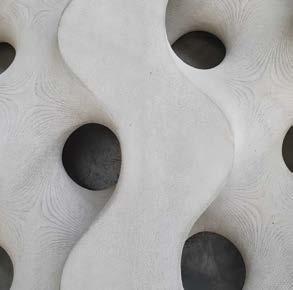
The self-cleaning coatings add to the myriad of precast’s sustainability benefits including:
• Use of local and recycled materials;
• Lead to better quality systems in the factory;
• Improved site safety due to less clutter;
• Minimal waste due to factory waste being recycled;
• Faster construction delivering economic benefits;
• Locally supplied to support Australian communities;
• Improved durability of structures because of better quality manufacturing procedures; and
• Minimal maintenance required with thermally efficiency.
These revolutionary coatings are being used in a
wide range of precast project applications, from the ANZAC Memorial to the Parramatta Leagues Club Carpark, to schools, universities, clubs and houses. More information can be obtained from National Precast’s website: www.nationalprecast.com.au

Progress Group's 3D Innovation
Construction Engineering Australia • November 2022 43 NATIONAL PRECAST NEWS
Interior design, statues, figures or entire façades can be realised by Progress 3D Innovation, a company of the Progress Group based in Brixen, using the innovative 3D printing process.
So too, the Engineer can use the vast capacity of Finite Element analysis to validate, optimize and adapt data to create the finest design solutions.


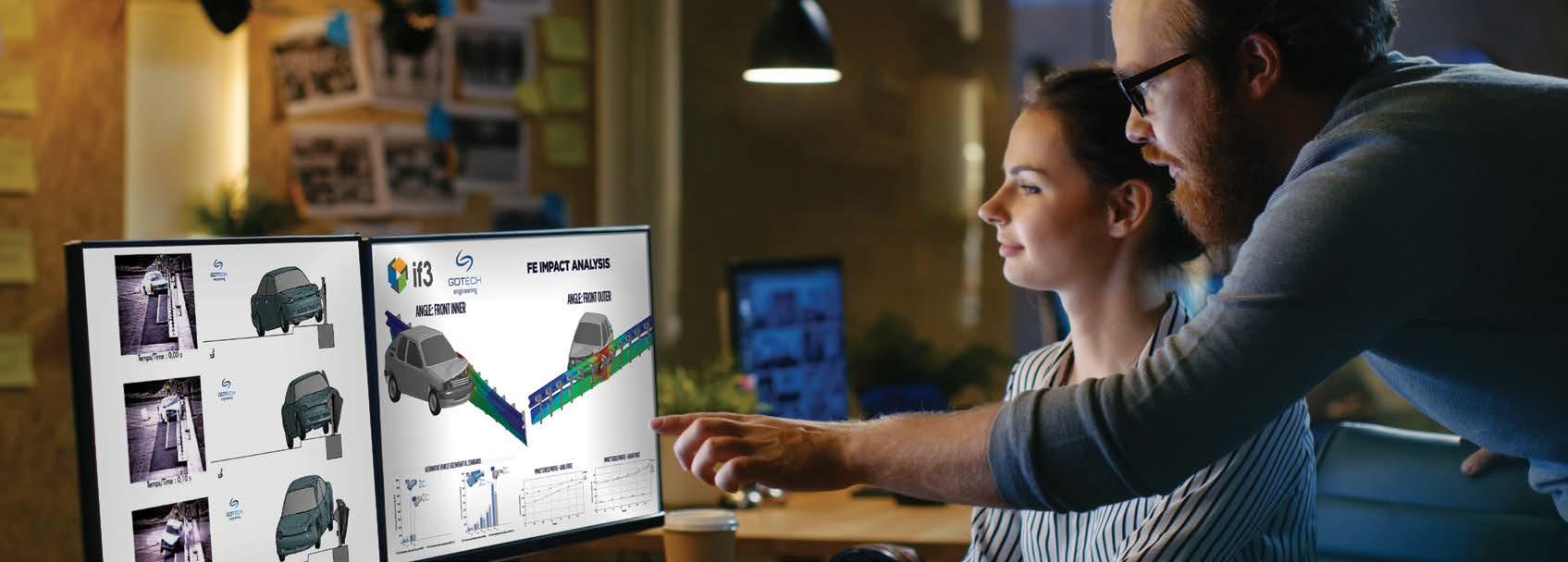





www.if3.com.au
Just as Conductors use all the instruments at their disposal to create the finest music...
COMPLIANCE TRANSPARENCY IS THE KEY TO RESTORING TRUST
 by Bill Maloukis, General Manager, Construction Specialties
by Bill Maloukis, General Manager, Construction Specialties
Australia’s building sector is moving through a difficult period. With both new engineering construction and dwelling investment down from last year, and the cost of supplies rising, the industry is under significant pressure.
We are also battling considerable distrust with the sector’s reputation marred by the Opal Towers, Mascot Towers and Neo200 incidents, to name a few. It’s not just here though. Five years on from the Grenfell Towers fire, construction worldwide continues to be viewed with suspicion.
The key to restoring the reputation of construction? Compliance.
Specifying building materials for commercial projects is often a careful balancing act of choices between design, functional requirements, budgets, timelines and product availability. Within this environment, it’s not surprising that safety is often considered as nothing more than a ‘tick a box’ – if a product is up to code, it’s good to go.
The issue though is that not all compliance standards are the same.
To re-establish trust we need more than ‘opt-in’ building product standards. The current National Construction Code (NCC) ‘fit-forpurpose’ guidelines do not go far enough. The code allows differing levels of testing across certification providers, making compliance a grey area, particularly when it comes to fire safety.
SMALL-SCALE FIRE REACTION TESTS PROVIDE UNPREDICTABLE RESULTS
As it stands, construction supply companies can satisfy the fire performance requirements of the NCC for surface lining products by passing a small-scale cone calorimeter test. However, as the test only requires a 100mm-by-100mm sample, the results are only predictive, and often fickle.
On the other hand, a full-scale corner room burn test requires surface lining products to be installed in the wall and ceiling of the laboratory testing unit, simulating a real-life fire environment. Within this test, the surface material can be truly evaluated for its contribution to fire spread and fire growth, as well as smoke production.
When internal lining products are involved in a fire, the speed of fire spread, and the rate of smoke production impacts the ability of the building occupants to evacuate. Linings that have not been adequately tested, or those with a non-compliant Group Number, can result in untenable conditions before the building occupants can reach a place of safety.
Full-scale corner room burn testing provides unequivocal evidence of a product’s reaction to fire. When it comes to fire safety, construction suppliers cannot afford to take a gamble – not when lives are potentially at stake.
46 Construction Engineering Australia • November 2022 COMPLIANCE TESTING
Full-scale testing is the only way to truly ascertain how a material will resist – or aid – fire spread, which is why Construction Specialties is advocating for this testing to be mandatory.
NO PRICE ON SAFETY
While this level of testing requires additional time and effort – as well as cost – for product production, it is an investment well worth making. The use of sub-standard supplies can cost not only your reputation, it can also risk unnecessary harm to people and property. For Construction Specialties, the investment in full-scale corner room burn testing is a small price to pay to safeguard both.
Used in hospitals, retail, hotels, education facilities and workplaces around the globe, Acrovyn® 4000 products have been subjected to a full-scale corner room burn test (AS ISO 9705-2003) and received a Group 1 rating and CodeMark® Accreditation.


Construction Engineering Australia • November 2022 47
“Full-scale testing is the only way to truly ascertain how a material will resist – or aid – fire spread, which is why Construction Specialties is advocating for this testing to be mandatory.”
Construction Specialties is committed to providing products that make buildings better; for us, that means not only providing premium quality, design-oriented materials, but paying close attention to safety.


For this reason, we put our Acrovyn® 4000 products through the full-scale corner room burn test (AS ISO 9705-2003) and received a Group 1 rating and CodeMark® Accreditation.

Popular in high-traffic areas such as lobbies, reception areas and lifts, as well as food courts and play centres, Acrovyn® 4000 can be found in hospitals, retail, hotels, education facilities and workplaces. It is a key design feature, ensuring the longevity of a building’s interior, while helping to reduce maintenance costs and the need for repairs and redecoration.
Acrovyn® 4000 is a PVC-free engineered fire-resistant material that is manufactured into a range of products used for wall linings, crash rails, handrails, corner guards, run plates and door frames. Its use in high-traffic areas meant establishing fire resistance was paramount.


MAKING THE RIGHT CHOICE, MADE EASY
When choosing products for a project, construction contractors and engineers need to know they’re getting the best materials for the job. This means not only being aware of the aesthetic appeal and durability of the product, but also its level of compliance.
It is possible to satisfy all these criteria; to choose products that deliver on design and longevity, while providing fire resistance to the property and its occupants.
Internationally recognised, CodeMark® accreditation allows building contractors and engineers to easily navigate material compliance so they know their project is quality assured.
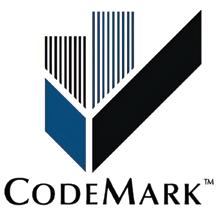
Choosing the right materials for the job shouldn’t be a complex task. Making full-scale corner room burn tests mandatory for compliance will not only eliminate the guesswork for contractors but raise the reputation of our industry.
PO Box 510
YES! I wish to receive a print subscription to Please find enclosed my cheque/money order for $______ Payable to Editorial and Publishing Consultants Pty Ltd OR please charge my o Mastercard o Visa o Amex Card Number : __ __ __ __ __ __ __ __ __ __ __ __ __ __ __ __ Cardholder
__ __ / __ __
______________________ Post
___________________________ Fax: Email: _____________________________________________________________ SUBSCRIBE SUBSCRIBE CONSTRUCTION ENGINEERING AUSTRALIA Within Australia ( $77.00 - 1 year, 6 issues o $135.00 -
years, 12 issues o $195.00 -
years, 18 issues Overseas R ates Asia Pacific o $AUD 120.00
year, 6 issues o $AUD 210.00
12 issues o $AUD 295.00
issues All other countries o $AUD 145.00
issues o $AUD 255.00
issues o $AUD 365.00
issues prices include GST) o
,
• •
Name: Expir y Date:
Signature: Name: Job Title: Company: Address: Suburb/Town:
Code: Phone:
2
3
- 1
- 2 years,
- 3 years, 18
- 1 year, 6
- 2 years, 12
- 3 years, 18
Editorial and Publishing Consultants Pty Ltd ABN 85 007 693 138
Broadford, VIC 3658 Telephone: 1300 EPCGROUP (1300 372 476) • Int’l: +61 3 5784 2210 • Email: subs@epcgroup.com
48 Construction Engineering Australia • November 2022 COMPLIANCE TESTING


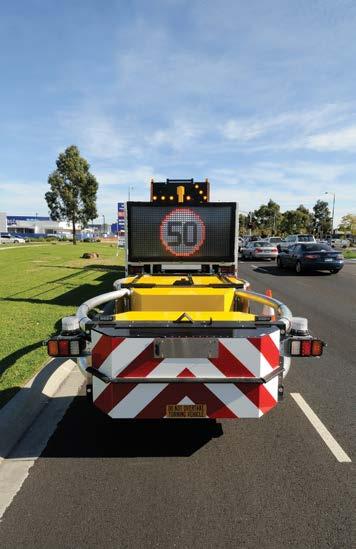












QUALITY EQUIPMENT SUPPORT SERVICE Whatever your line marking or tra c management requirements, A1 Roadlines has the equipment and expertise to meet your needs. THE EQUIPMENT YOU NEED – THE SERVICE YOU EXPECT A1 Roadlines Pty Ltd | 89 Rushdale Street, Knoxfield, Victoria 3180 | www.a1roadlines.com.au P: 1300 217 623 (A1ROAD) | F: (03) 9765 9499 | E: sales@a1roadlines.com.au
PRECAST TECHNOLOGY COMPLETE WORLDWIDE
Highly automated and customized carousel plants
Reinforcement machinery and mesh welding plants
Battery moulds, tilting tables, various mould systems
Slipformer, Extruder, equipment for production on beds
In-house precast production and in-house testing plant
Software for machinery and complete ERP systems
www.progress.group





































































































































































































 Figure 1 – Strength Development for 20MPa footing using a mix with 20% RCT 323 aggregate replacement
Table 1 – Mix characteristics using 20, 30 and 50 per cent RCT 323 aggregate replacement
Figure 1 – Strength Development for 20MPa footing using a mix with 20% RCT 323 aggregate replacement
Table 1 – Mix characteristics using 20, 30 and 50 per cent RCT 323 aggregate replacement




 Figure 2 - Control Mix
Figure 2 - Control Mix

















































 by Bill Maloukis, General Manager, Construction Specialties
by Bill Maloukis, General Manager, Construction Specialties






















